Egyptian Art and Architecture
1/126
Earn XP
Description and Tags
Flashcards covering key terms related to Egyptian art and architecture, particularly focusing on different periods and artifacts.
Name | Mastery | Learn | Test | Matching | Spaced |
|---|
No study sessions yet.
127 Terms
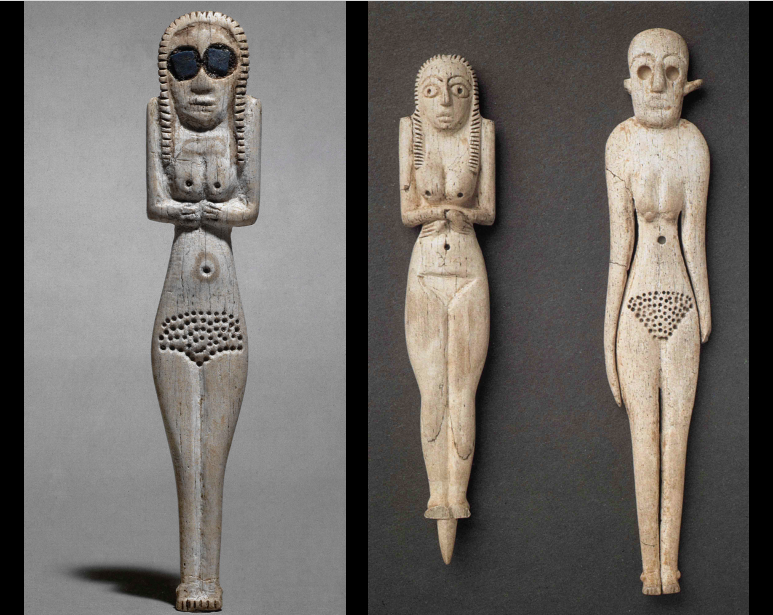
What is this?
Figurine
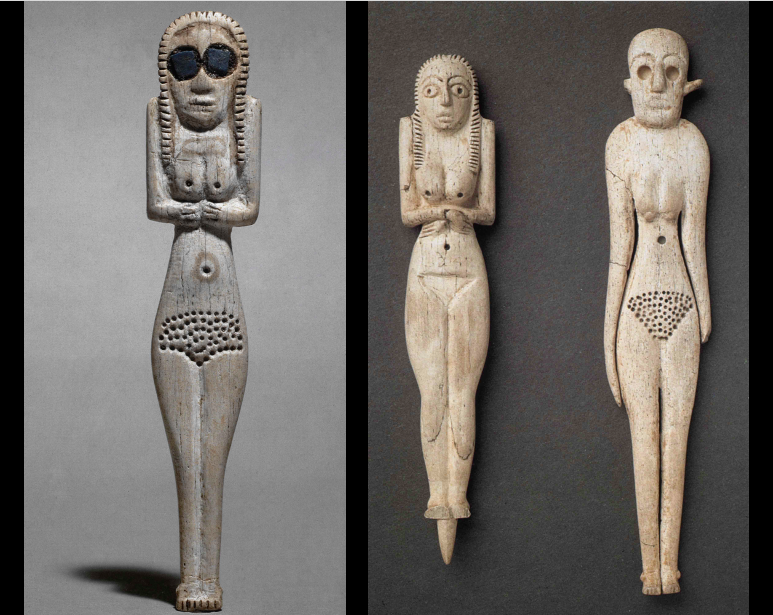
What material is it made of?
Ivory
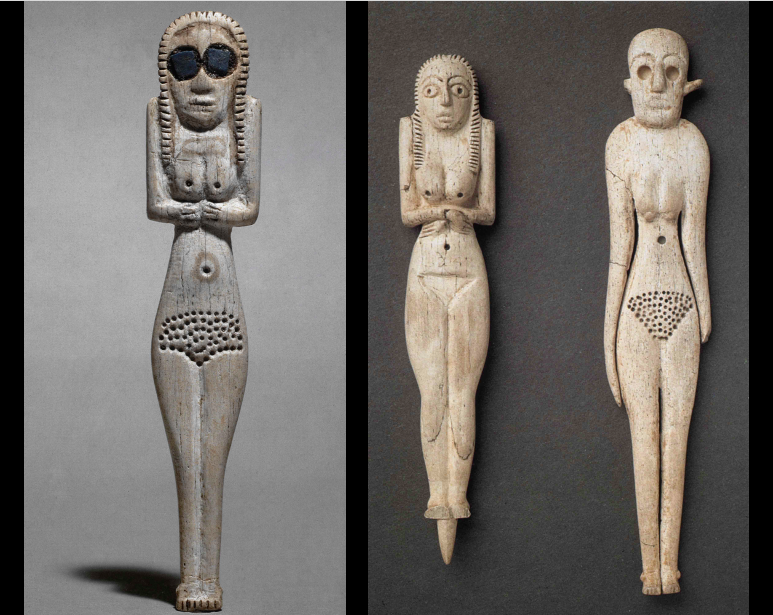
What time period is it from?
Naqada I
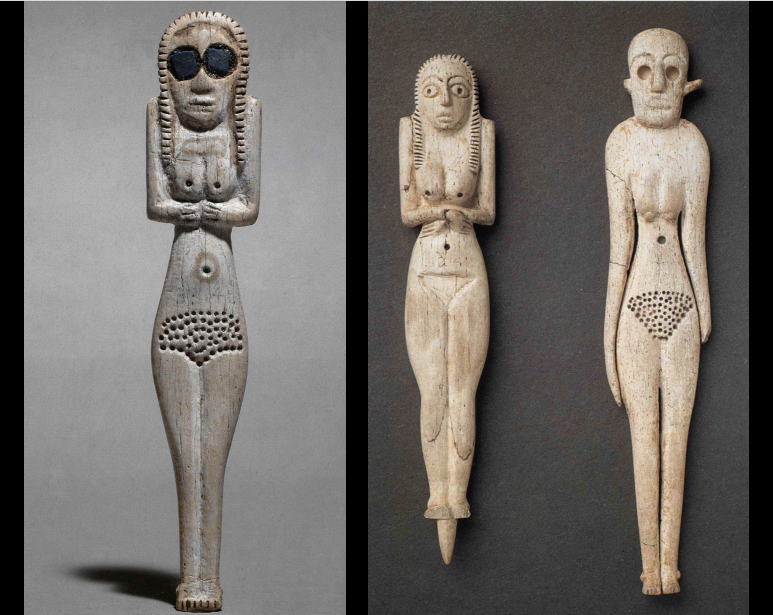
Where can it be found?
Usually found in tombs
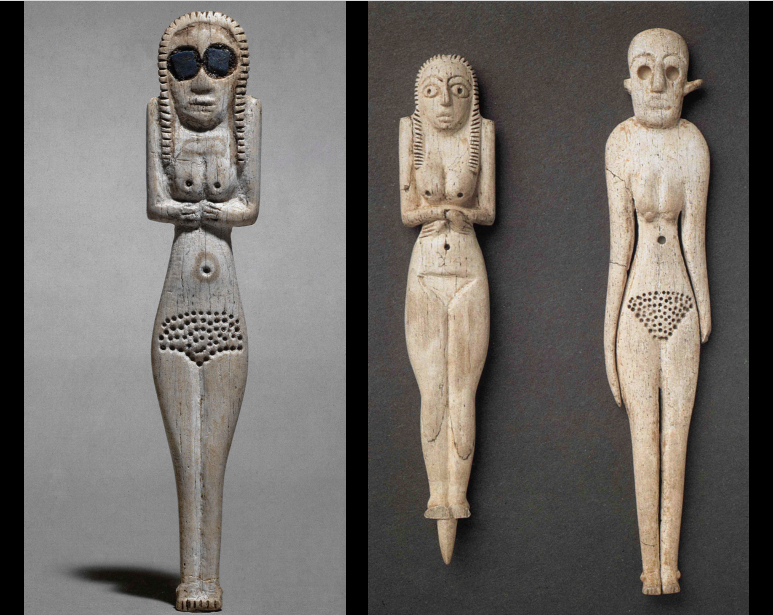
What is its significance?
The emphasis on genital areas suggests something to do with fertility, and the fact that they are found in graves suggests maybe some ideas tied to the afterlife
Figurines are linked to status (very small minority had them in their tombs)
Continuity from the Badarian period
Riam’s Notes:
“Naqada 1 had a lot of figurines, emphasized pubic hair and breasts, and were probably associated with fertility based on shape. Fertility can go two ways: one way is childbirth, and the other way is rebirth. Mainly found in tombs because childbirth was very fatal.
One was made with lapiz eyes, which tells us the eyes were coming from somewhere else. Egypt had no lapiz at the time, and the closest area was Afghanistan, so that shows that Egypt was trading.”
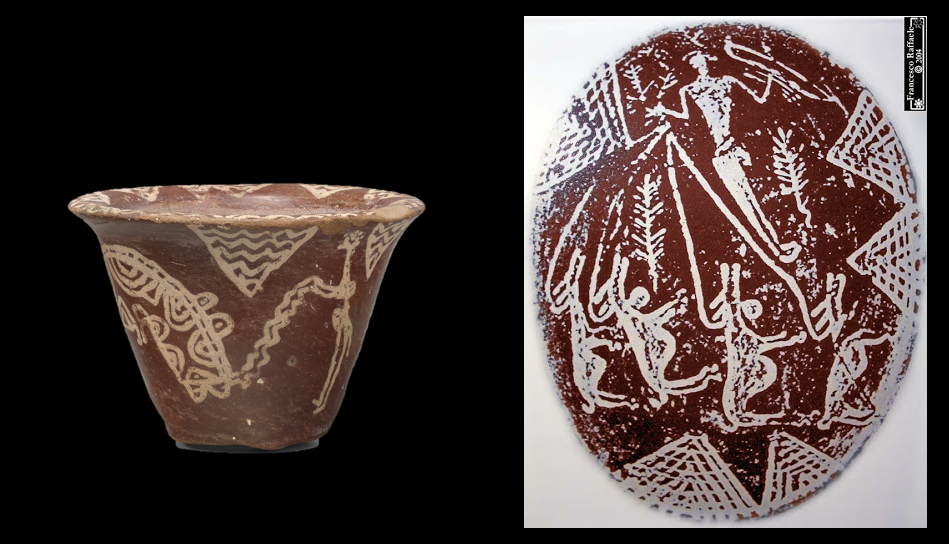
What is this?
Naqada I pottery
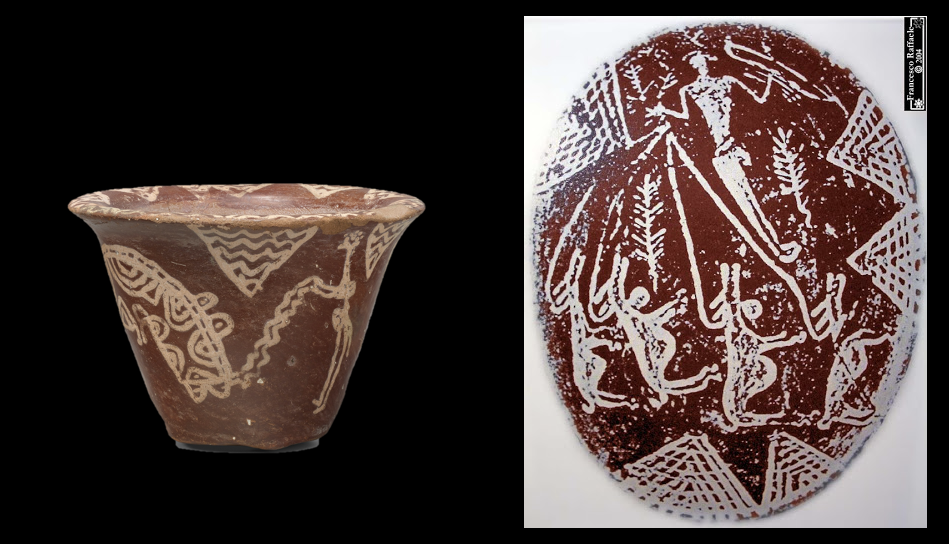
What material is it made of?
White Cross-lined Ware
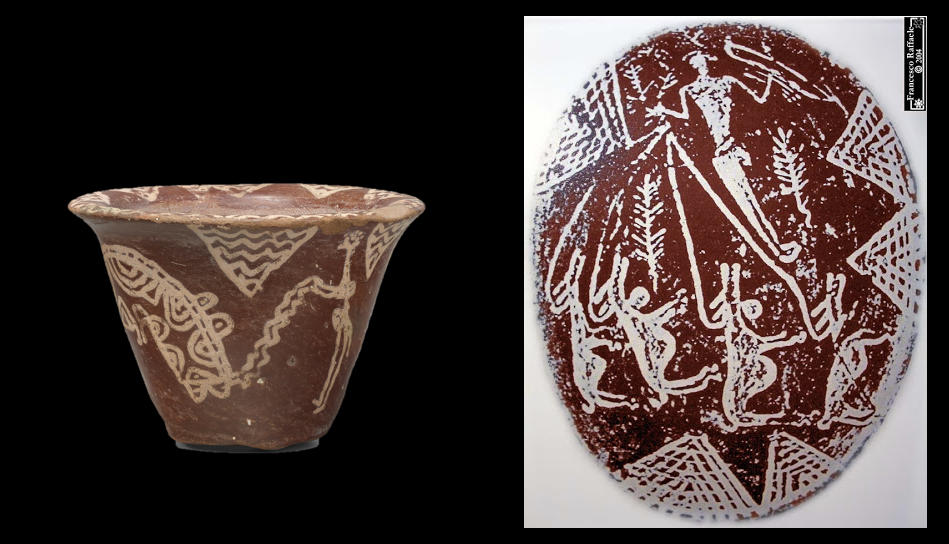
Where can it be found?
Usually found in tombs
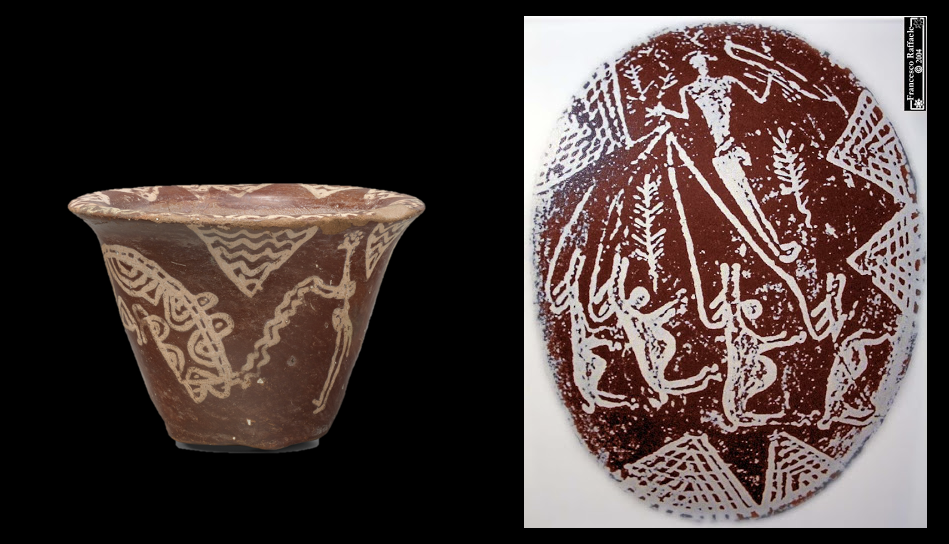
What is its significance?
Humans controlling animals, which is often read as “order vs chaos.”
This type of pottery often had hunting scenes, animals in general, geometric forms often interpreted as landforms, the river, plants, etc.
Riam’s Notes:
“Badari is one of the only Egyptian sites that is a bit earlier than what was going on in the rest.
Badari is where predynastic culture starts in Egypt and then it expands
Black top in the pottery and ceramics is Badarian.
Naqada 1 is known for the black top pottery
Other student: “The first picture shows a hippo hunt, an appearance of nature themes. Pieces such as these are usually found in tombs, but could be used in life. The second picture shows one person “ruling over others”, perhaps farming”
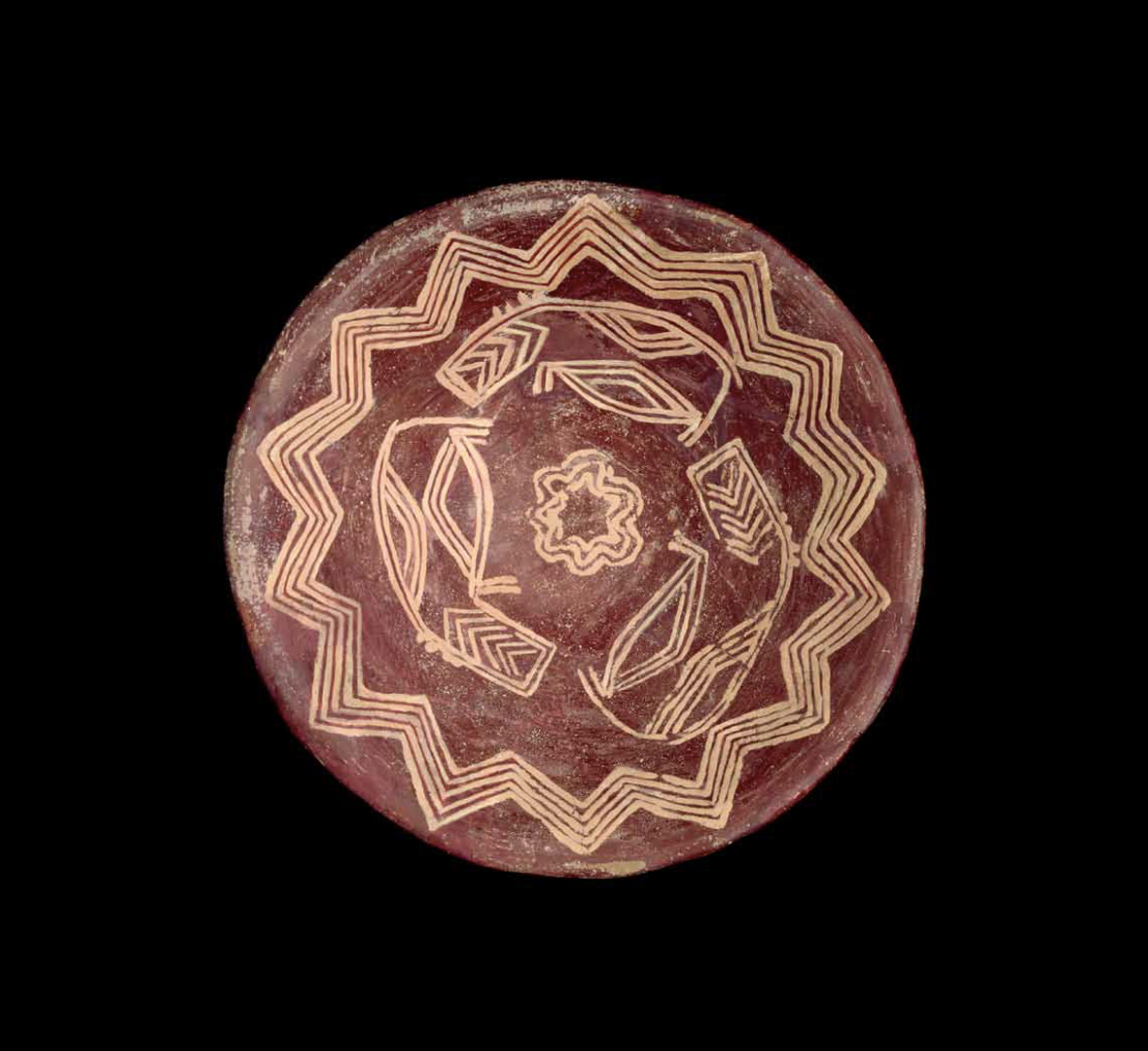
What is this?
Naqada I pottery
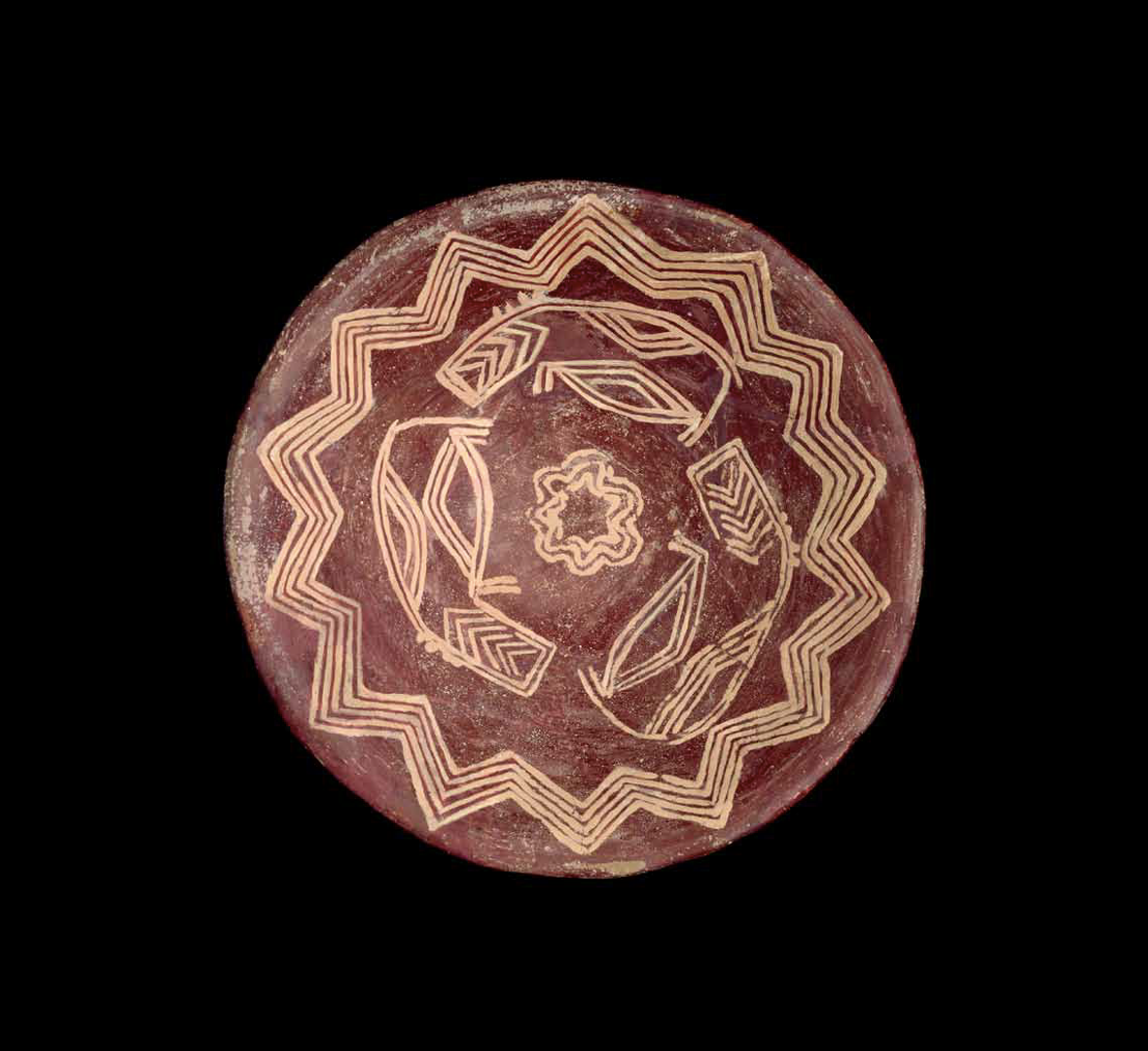
What is it made of?
White Cross-lined Ware
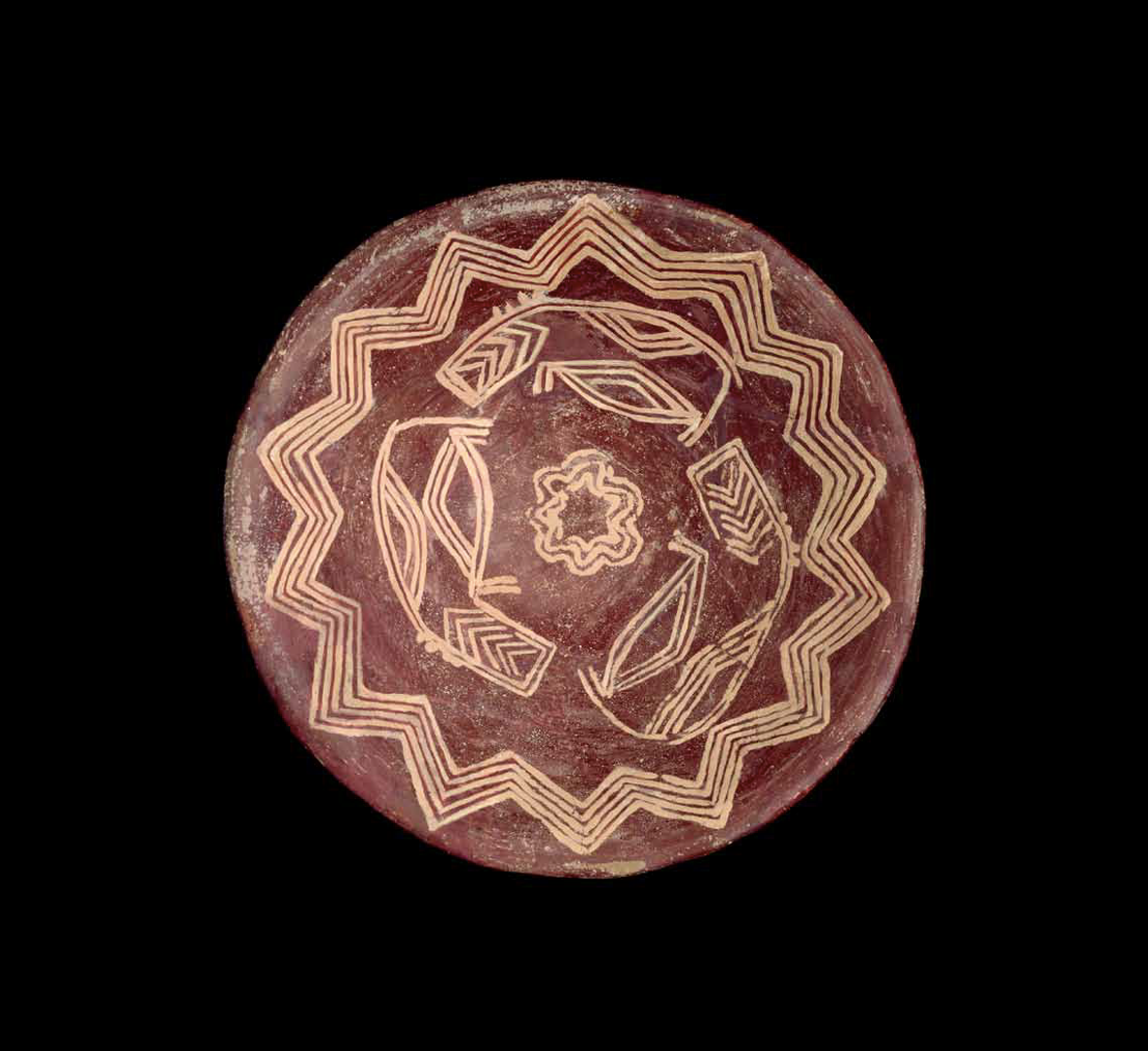
Where can it be found?
Usually found in tombs
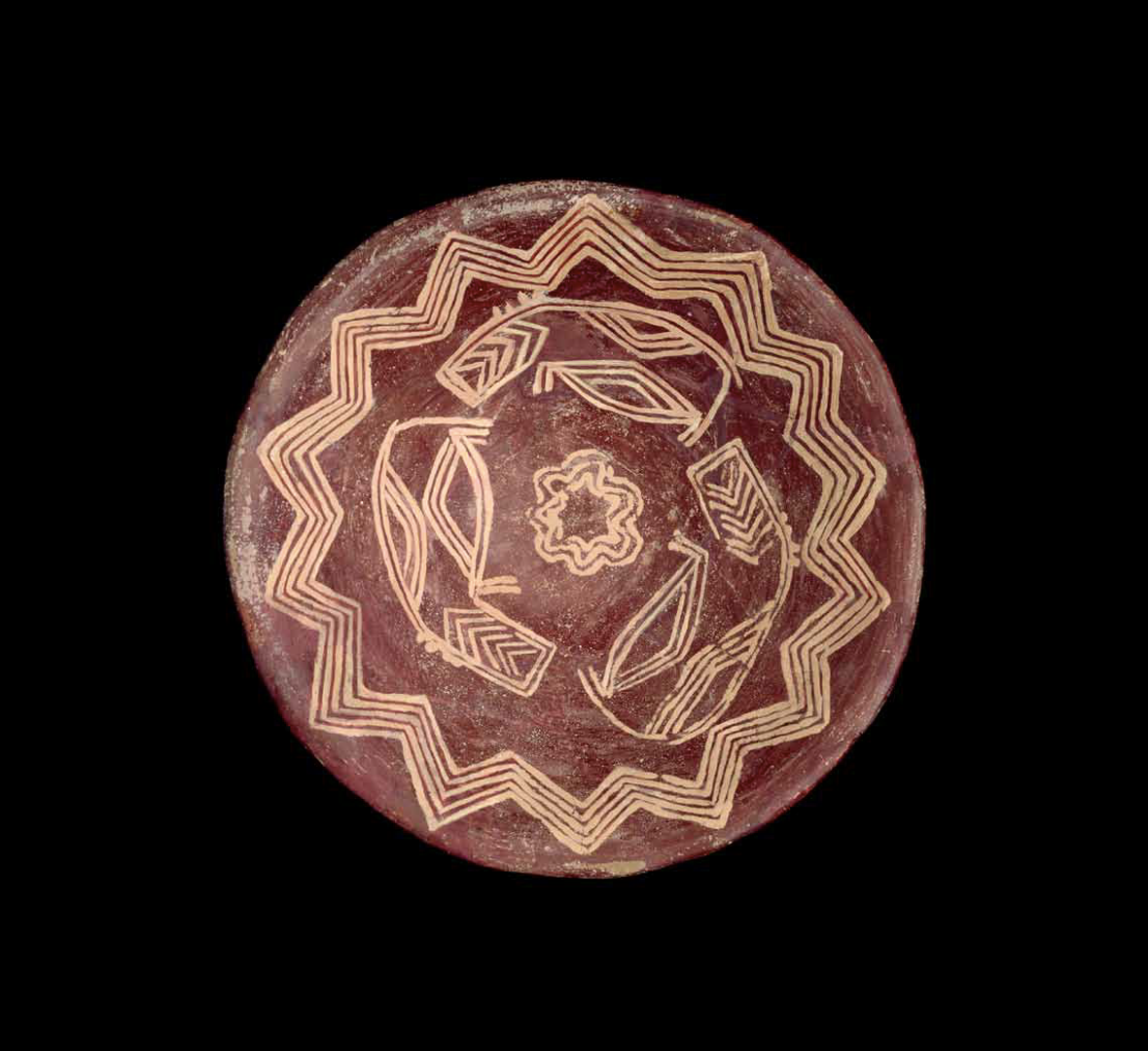
What is its significance?
Images such as this – showing hippopotami chilling in a pretty organized manner – have also been tied to the idea of “order vs chaos” (don’t go into depth abt maat vs isfet here, but maybe gesture to it
Other student: Shows how motifs began to change - nature still appearing. Hippos were often in hunting scenes but not in this piece.

What is this?
Palettes
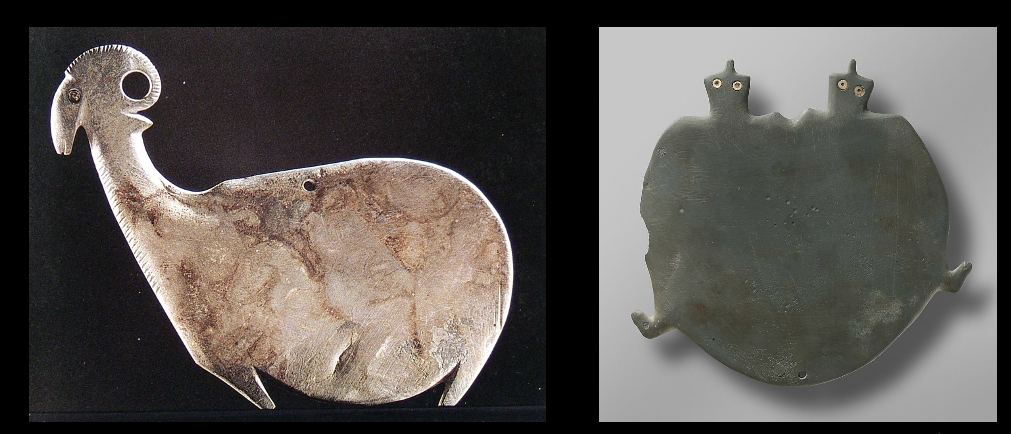
What is it made of?
Stone
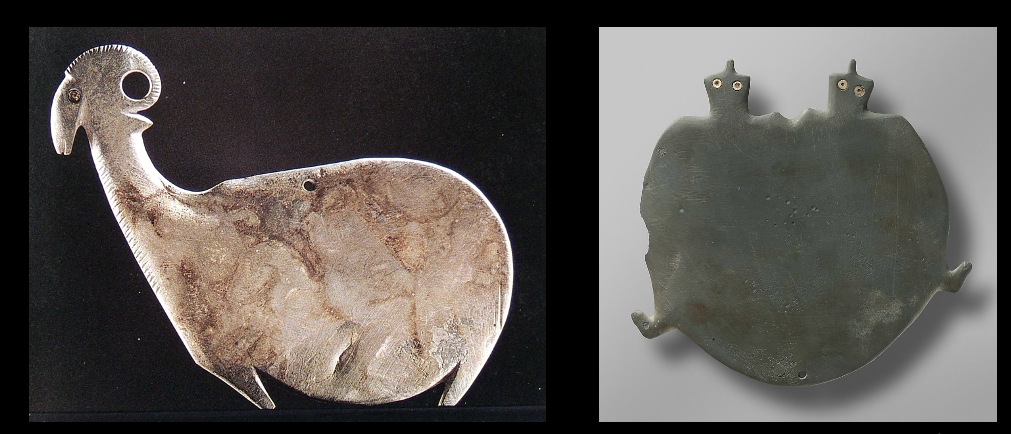
What time period is it from?
Naqada II
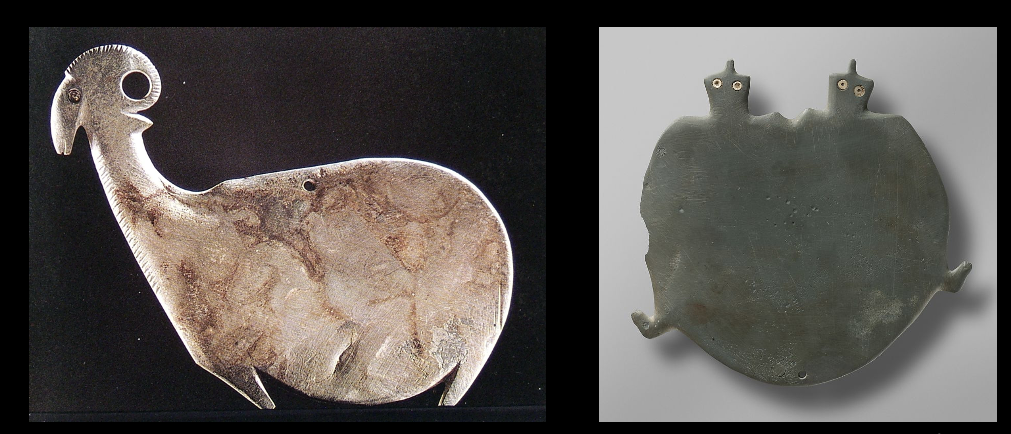
Where can it be found?
Usually found in tombs
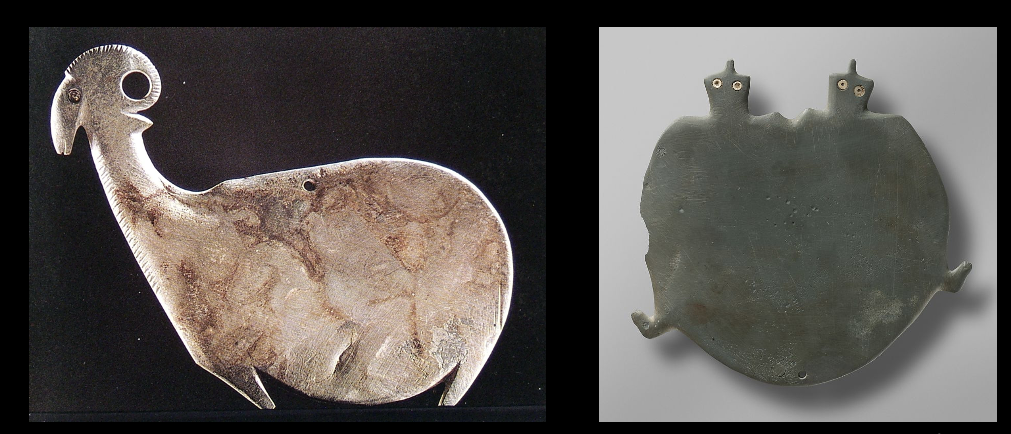
What is its significance?
In Naqada II, they get more elaborate but continue to be associated with themes from the natural world, something that will change in Naqada III (which we’ll see next week)
Highlight that these palettes are an elaboration of the palettes we already saw in the N1, but are more elaborate.
Riam’s Notes: “Palettes are made of silksone and are made of shapes and have carving in them. Used to grind makeup, two types of makeup - Malachite, which was green, or smth that was Black.
Palettes are symbolic, the hippo is considered a dangerous animal, and many have died from hippo attacks. Having objects like this in your grave or in your life marked status. Not everyone was walking around with a very nice palette.”
Other student: “Motifs of animals (ram and two headed turtles) as everyday use of makeup palettes, used by the upper class. We know it is a makeup palette because of the residue found on the objects. Turtles were more common than rams.”

What is this?
Naqada II pottery
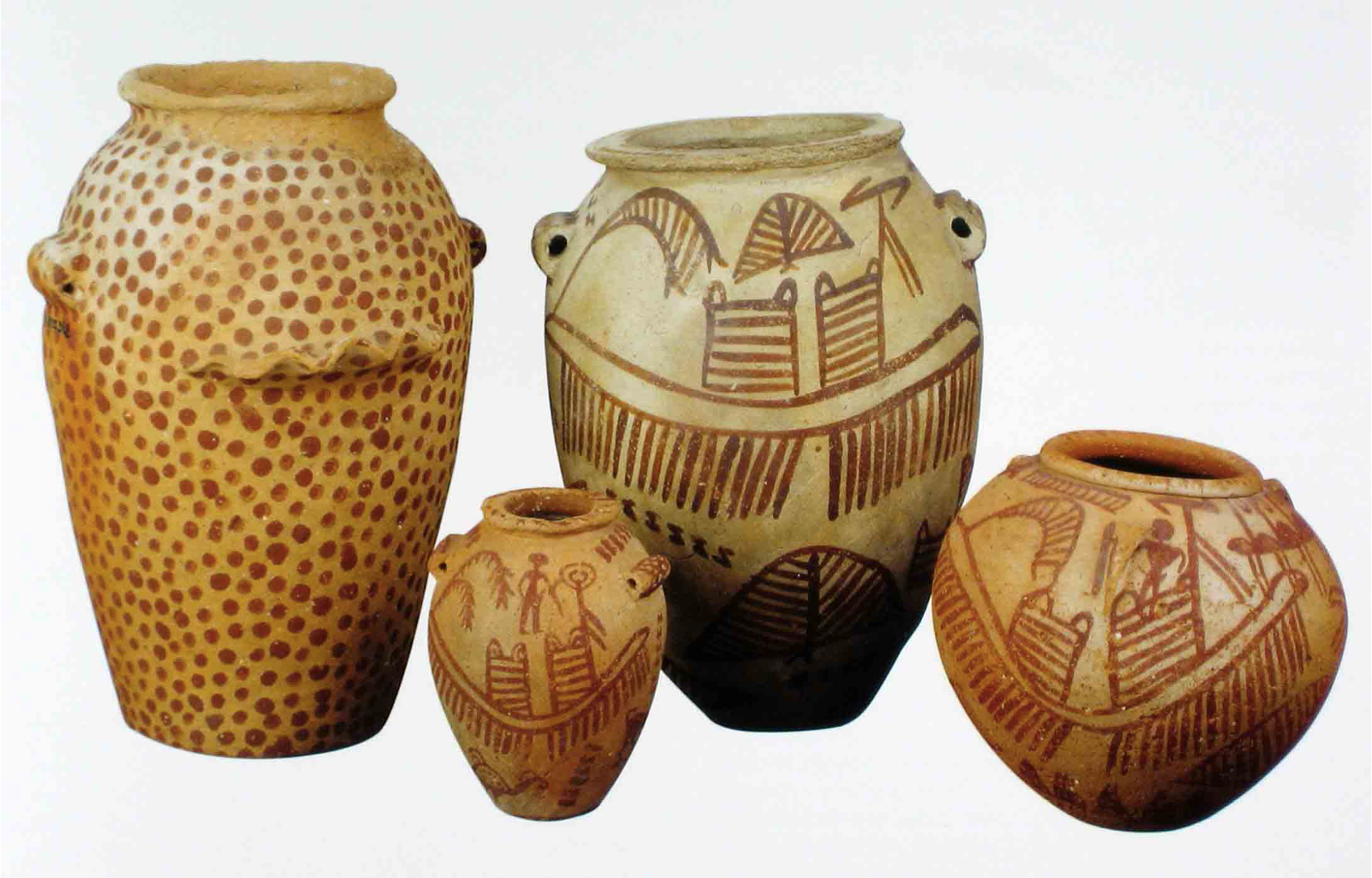
What is it made of?
Decorated Ware
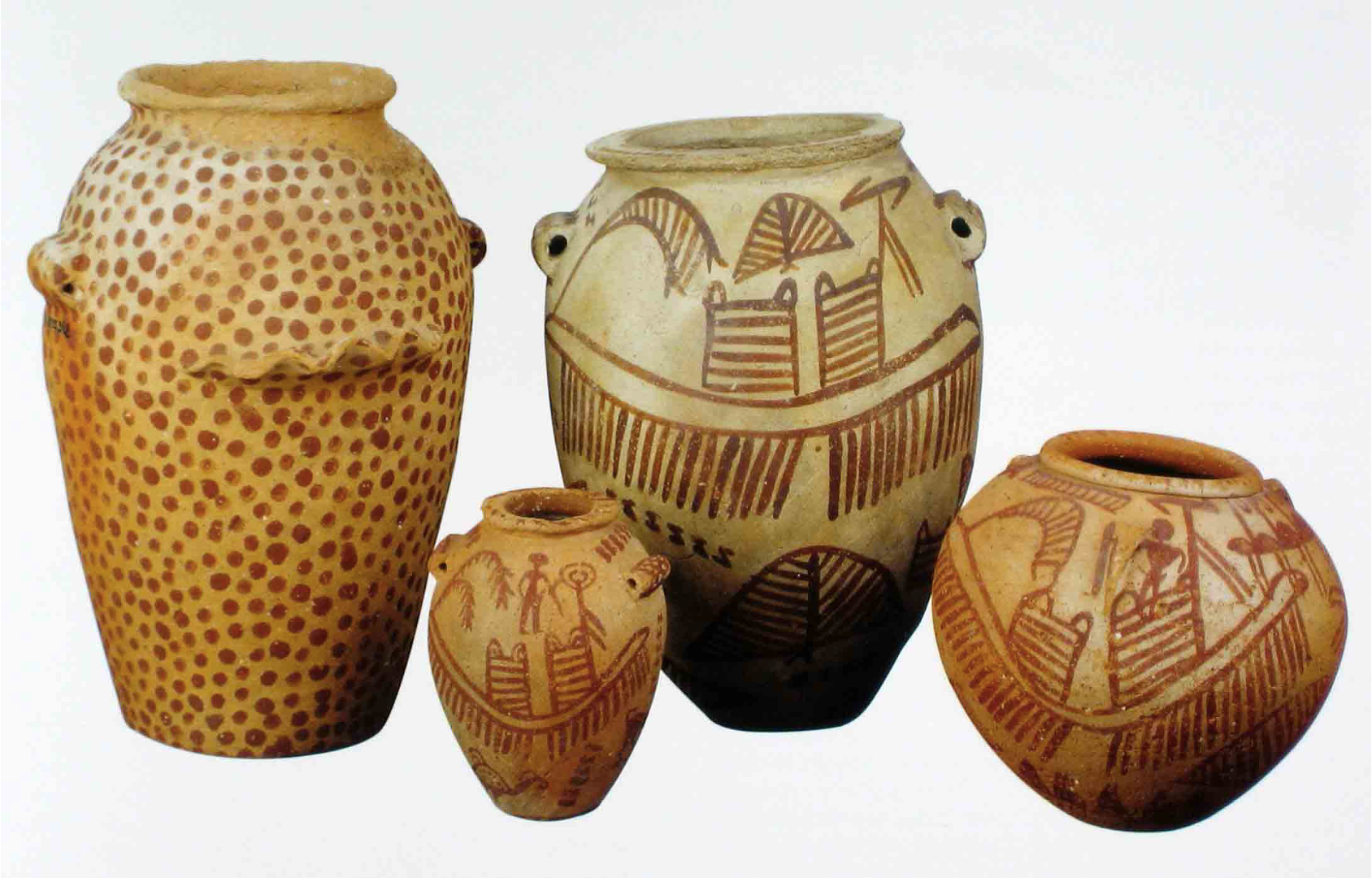
Where can it be found?
Usually found in tombs
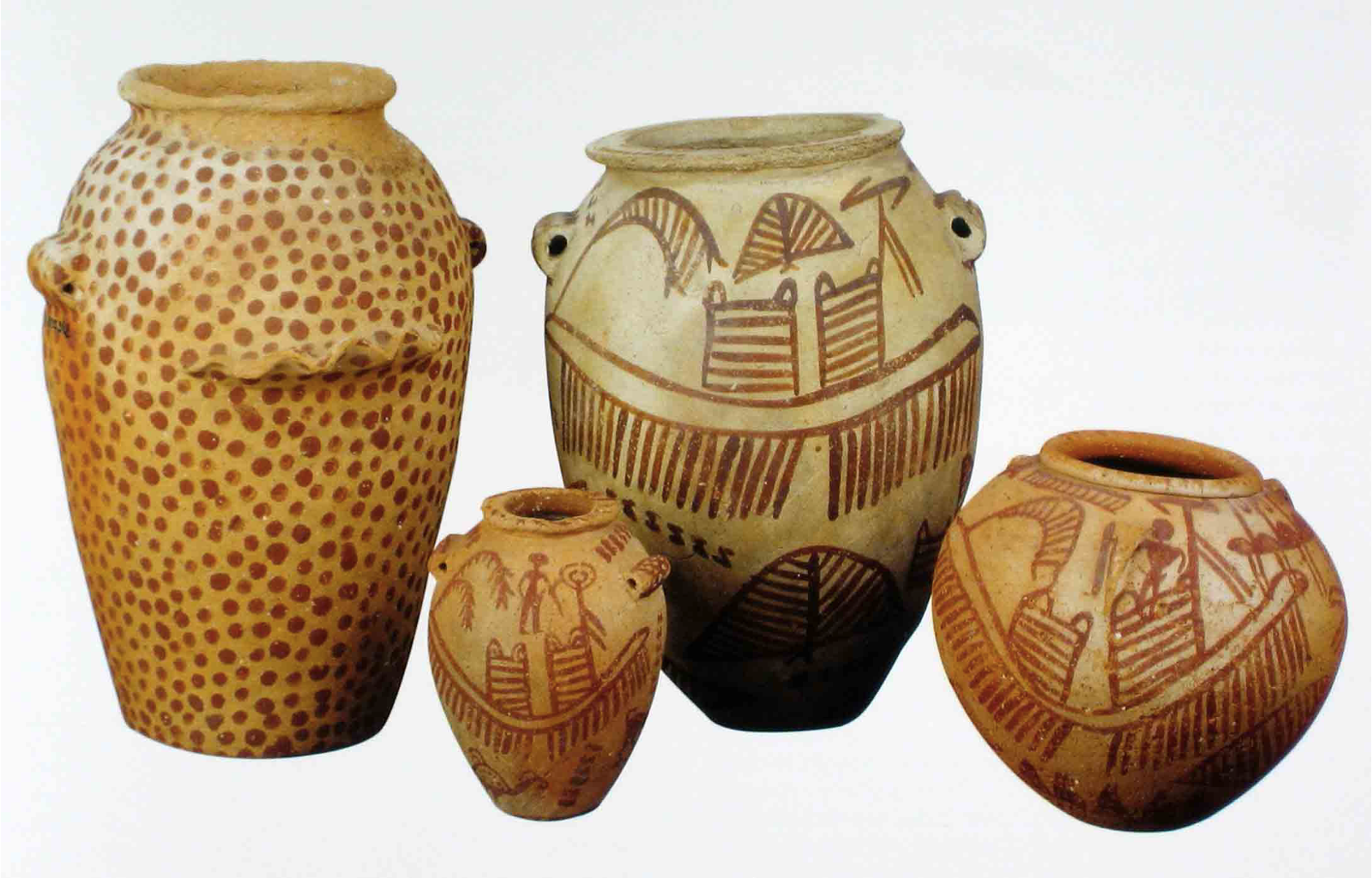
What is its significance?
White pottery with red lines (clay from cliffs)
Motif of domination over the natural world (boats), but no longer violent images (if that’s what we had before); also no hunting; usually tied to the funerary realm because they’re found in funerary contexts, but that is problematic, in particular due to the similarities of the motifs in NON-funerary contexts
Designed to look more expensive (like stone), also more standardized than White cross-lined, but still some variation across different vessels
Boats appear several times in ritual ceremonies. An important distinction is that this type of pottery doesn’t have themes of violence; it focuses on boats and figures with arms above their heads.
Riam’s Notes: “Naqada 2 is known for the rough pottery and other forms of pottery, as well as new materials and elements being used, such as flint metal.”
Other student: “The pieces have humanistic characters featured on boats which could signify travel and commerce because of the role the Nile River plays in Egyptian culture. Also shows a change in color which could represent a change in religious believes and motifs.”

What is this?
Tomb 100

What is it made of?
Paint on mudbrick wall

Where is it found?
Hierakonpolis

What time period is it from?
Naqada II

What is its significance?
Boats obviously a prominent motif which fits with what we’ve been seeing of Naqada II
It’s a double-chambered mudbrick tomb with painted walls
Riam’s Notes:
“The tomb was lost because the location wasn't written down, and the wall was taken to a museum in Cairo.
The man holding the two animals has a lot of motifs that can be seen in Mesopotamia and Iraq. The boat connected with the ceramics is believed to be the beginning of the smitting scene.
Painted, so most likely a high-status person is buried there.”
Other student: “Earliest known example of a painted tomb. The painting shows smaller scenes of women dancing, men fighting, and interaction with animals. We can also see a figure that is slightly bigger than the others holding something that we can connect to a crook, “smiting” enemies, could be an early depiction of a king.”
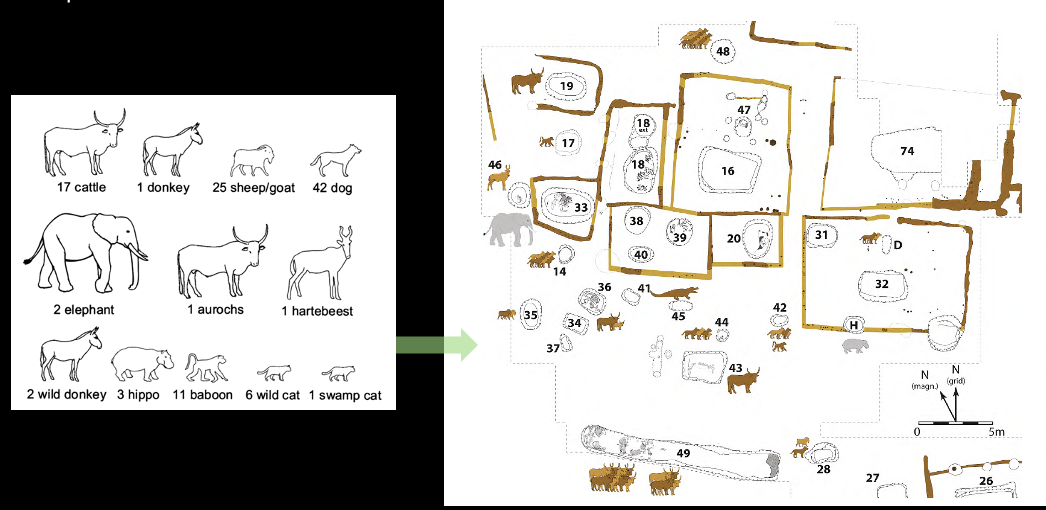
What is this?
HK 6 cemetery
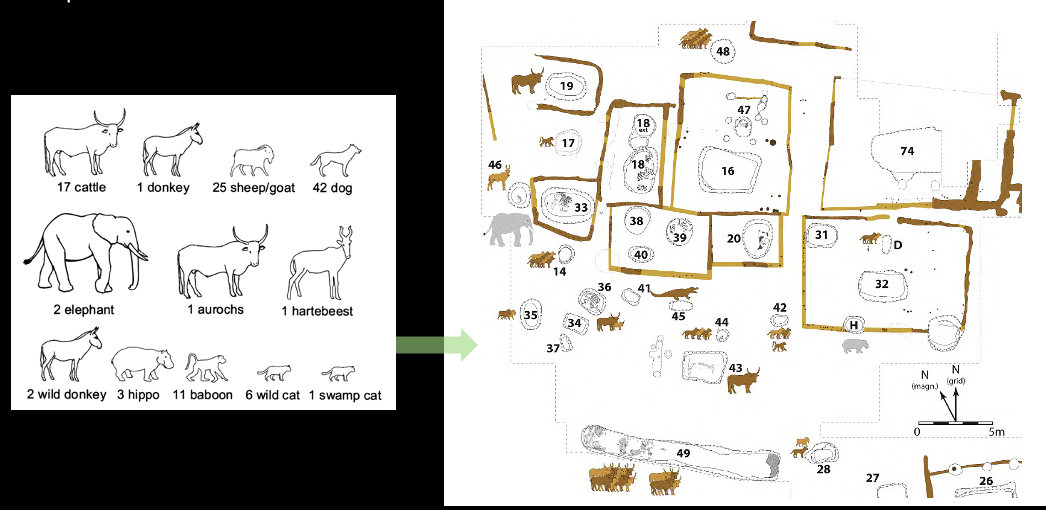
Where is it?
Hierakonpolis
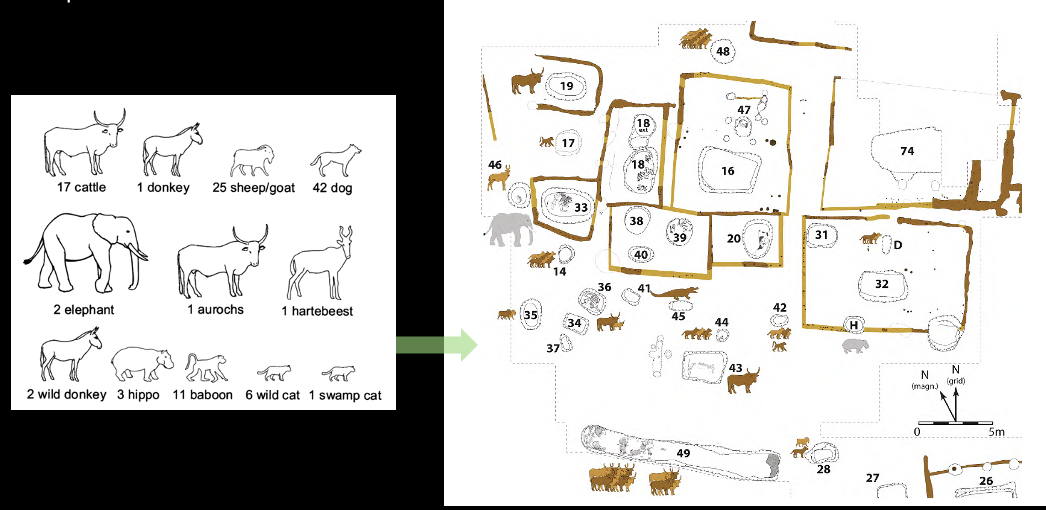
What time is it from?
Naqada II
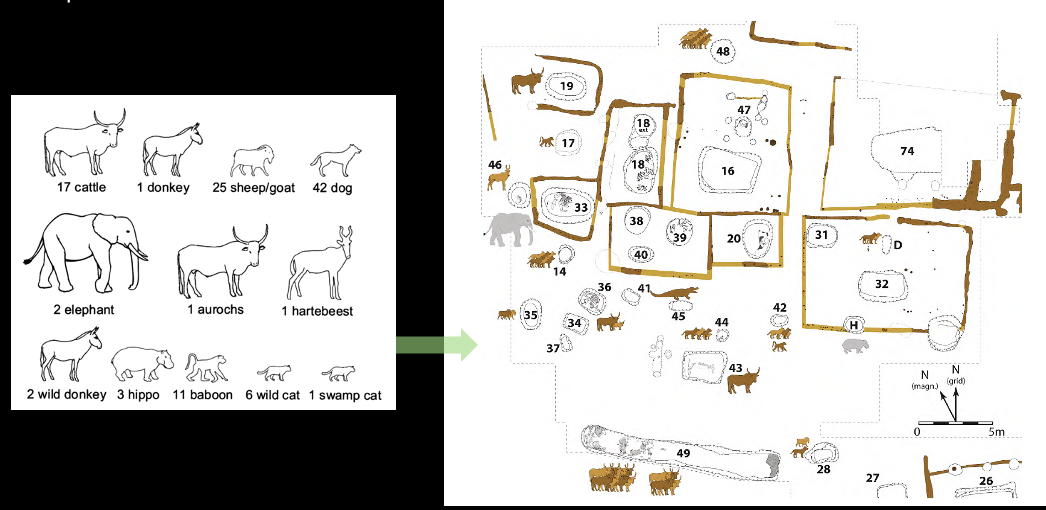
What is its significance?
Tomb 16 is one of the richest and largest tombs found in this local elite cemetery
This tomb complex is absolutely massive
Associated with the main burial are satellite or subsidiary graves that are connected by wooden walls
In these 13 tombs directly flanking tomb 16 were 36 individuals
Bodies of young men, women, and children were all found
2/3 of them juvenile under 15 years old = not normal mortality
Fine artifacts in all of the human tombs indicate high status owners, presumably family and courtiers
Burials of animals, both domesticated animals like cattle, dogs, cats, and goats and wild animals like three baboons, an elephant and hippos were also found on the outer perimeter of the tomb complex
Animals show the high status – some of these are exotic and would have been hard to get
The dangerous animals also likely use for protection (tie back to Tomb 100)
Riam’s Notes:
“Locality Hk 6L Tomb 16, Naqada 1 or 2 period. Some are just pits while others have walls, indicating pseudostartification. Tombs with walls around them are wealthy, high-status indications. The walls and separation
Tomb 16 is massive, and the tombs around it seem part of a complex.
Some of the 36 people who were buried around were as young as 15 years old.
Everyone was buried AROUND tomb 16.
In addition to human burials, there were animal burials. There was an elephant, a leopard, cattle, and a baboon.
Tomb 16 is where the local chief would be buried. Some associated burials could be family members or loyal members. All the ones touching tomb 16 are the ones touching it. HK6 masks could be the funerary masks that indicate funerary rituals. They are made out of clay and strapped onto the face. They then advance into fired clay masks.
Tomb 23 had some funerary goods, and the earliest human life-sized statue made of limestone was found in Egypt. The statue is fragmented into tiny pieces dispersed around the tomb. It was the first time it had been found in Egypt, so it's important to note that. The fact that it's found in small pieces is a bit suspicious, so it was pretty certain;y destroyed in ancient times. It's unknown why, if it belonged to a local leader, or if an enemy destroyed the statue.
Locality HK6 from Naqada 2 or 1 can say that the tombs are wealthy and tell us about structural stratification that can be seen with the burial of animals. They procured the wild animals, which required resources. The wild animals weren’t in Egypt then, so they would have had to leave their area to get them.
The masks that were found and the tomb complex tell us that there were already funeral rituals
The statue is the first human-sized representation that we have in limestone.
Abydos has a really big cemetery,
Cemetery B is where the first kings of egypt start to get buried’
Other student: “Tomb 23: Earliest human life-sized statue made of limestone. Fragmented in tiny pieces dispersed around the tomb. Tombs with nicely built walls are related to high status. Animal burials of domesticated (cattle, donkey) and wild animals (Baboons, leopards).”
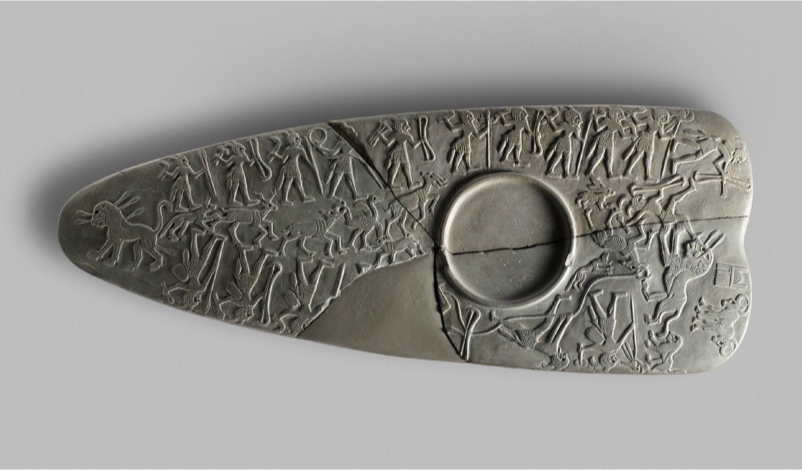
What is this?
Hunters’ Palette
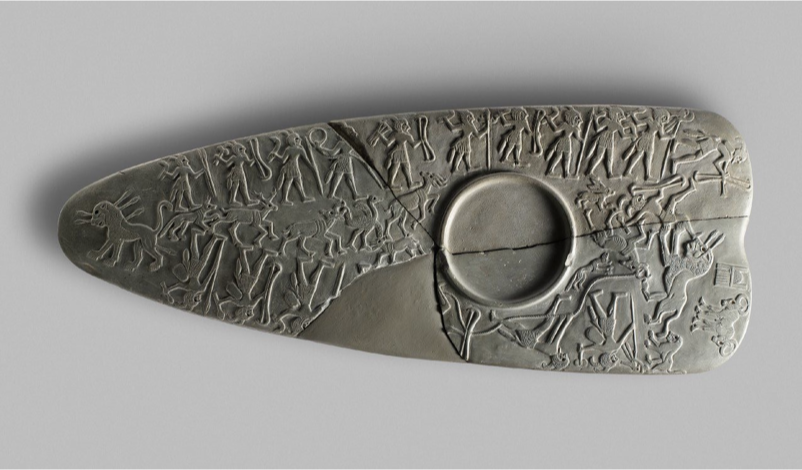
What time period is it from?
Naqada III
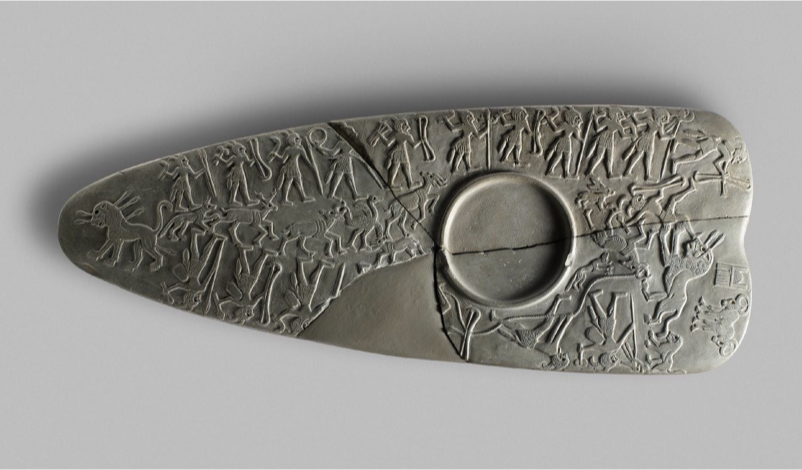
What is it made of?
Schist
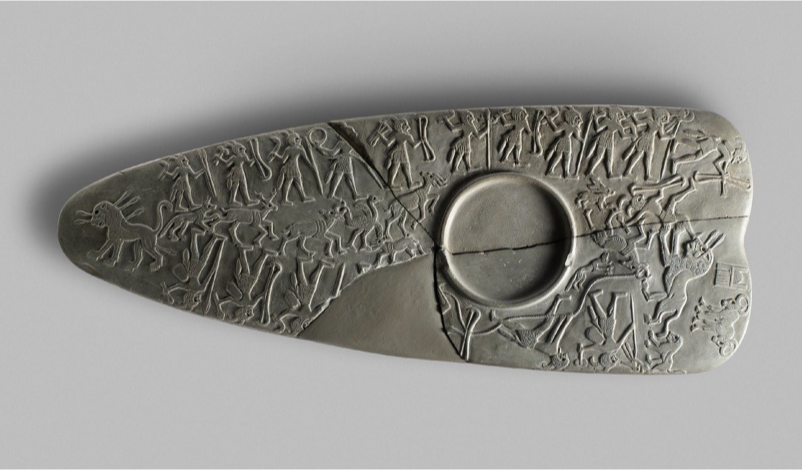
What is its significance?
As you can see for example in this example, iconography is already much closer to what we see in the dynastic period, but we still have a lack of precise order (and registers) and there are still some horror vacui vibes
Mention the issue that this is a lion – later a symbol for kingship, so what is it doing here?
Riam’s Notes: “has a bunch of hunters on the top, 2 lions that have their head stuck in something showing that humans have their nature smth back.
The circle in the middle is the grinding circle where u actually mix the makeup and suggests that these palettes may still be functional. Took a lot of time and sophistication
Riam’s Notes:
“From Naqada 3, Hunter’s palette, made of stone, clearly developed from Naqada 1 and 2, but here it's more sophisticated, talks about its use for makeup, talks about the humans fighting animals symbols.
The battlefield palette from Naqada 3 has animals that dominate humans, which is different from what we’ve seen. Since it’s so odd, some people think that the lion is a king, especially cause the lion later becomes a symbol for a king.”
Other student: The rows of hunters using different weapons towards animals, but the way they are lined up on the outside with the animals on the inside suggests a shift from hunting for necessity to hunting for rituals. It is believed rituals because of the “hut” at the top.
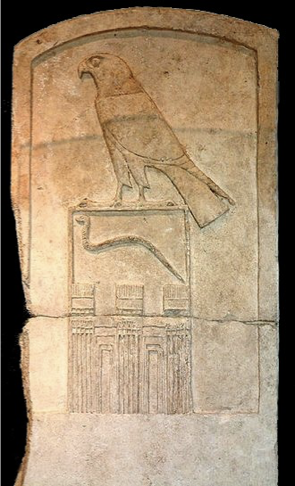
What is this?
Stela of Djet
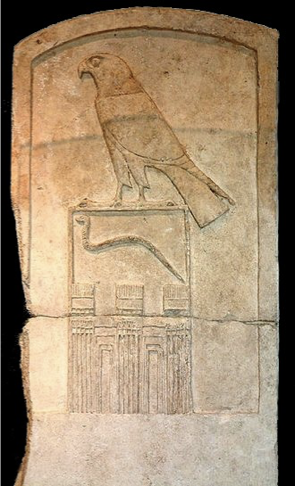
What is it made of?
Limestone
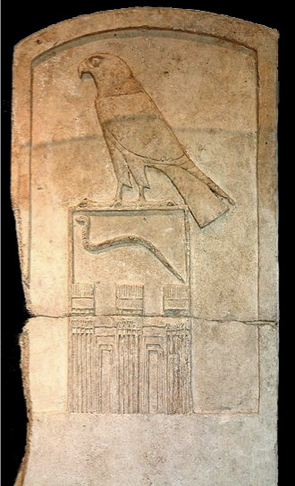
What time period is it from?
Dynasty 1
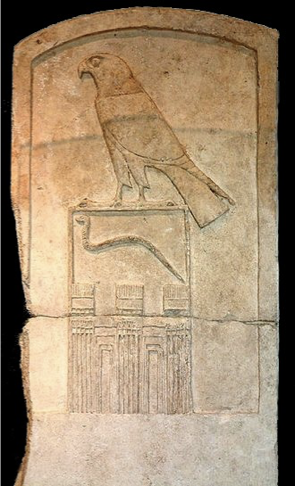
Where is it found?
Abydos (Umm el-Qaab)
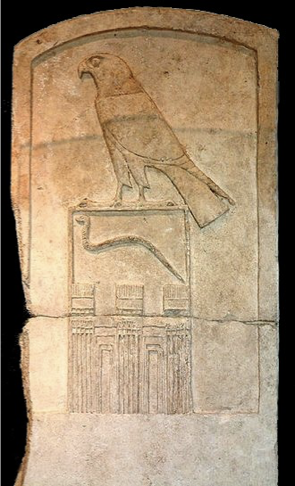
What is its significance?
Riam’s Notes:
“There are several of these from Dynasty 1 with different names and is associated with royal names at a tombsite.
Names with Stela (Steeeeleee) (curves stone) dignfies status and most likely members of the royal court, sacrifices or not
Development of the Serekh has the symbols that can be seen with kings. When you start seeing Serekhs on wine jars for example then it refers to kings. When seeing the horus then theres something going on with kings. The empty rectangle/ rectangle below the horus is for the royal name. The third symbol that looks like a bunch of archs is an architectural facade, likely a part of a building being depicted because a lot of buildings from that time period have exterior walls that look like that. Those three factors make up the Serekh.
Djet is the curvy snake hieroglyph”
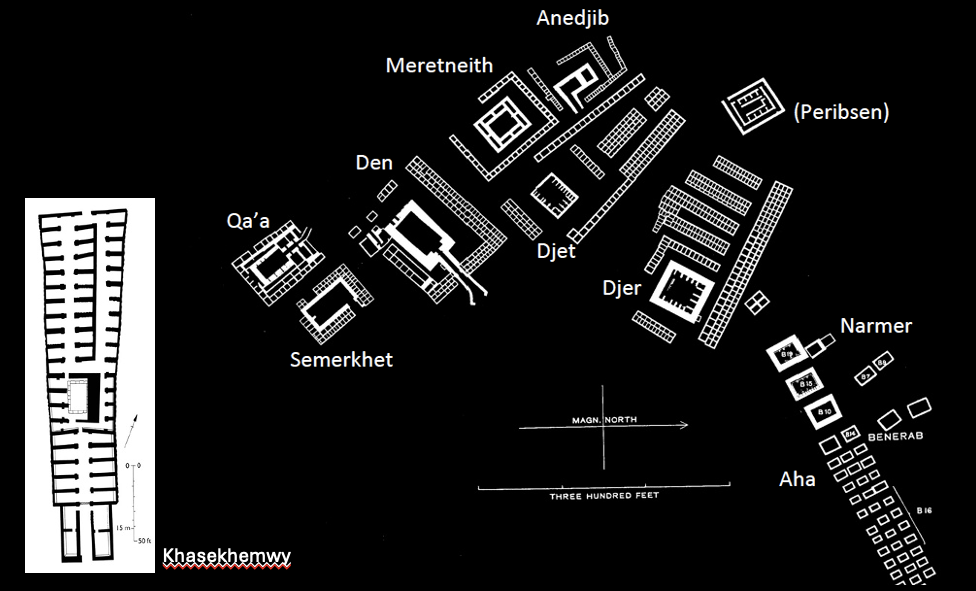
What is this?
Umm el-Qaab, Necropolis
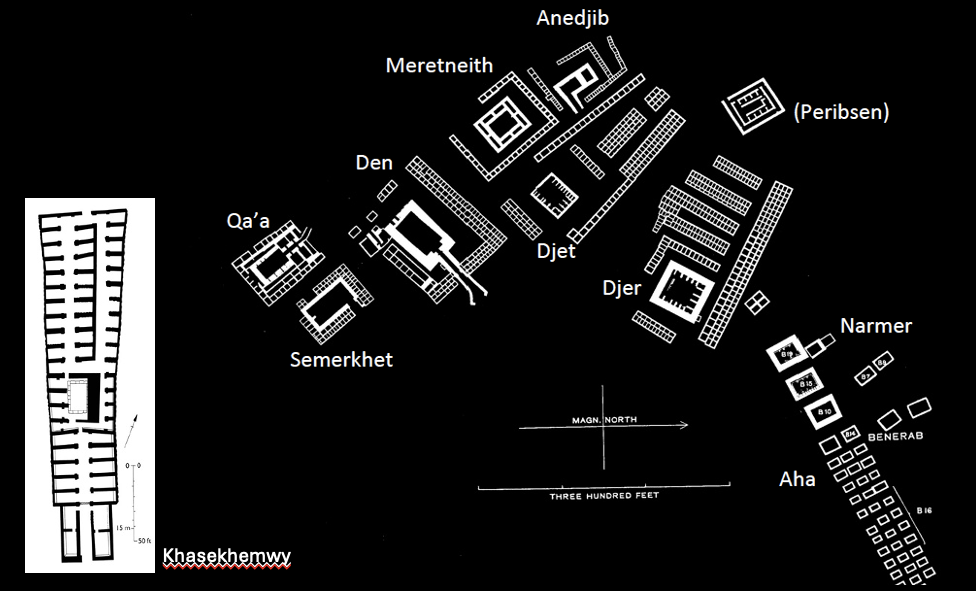
What is it made of?
Mudbrick tombs
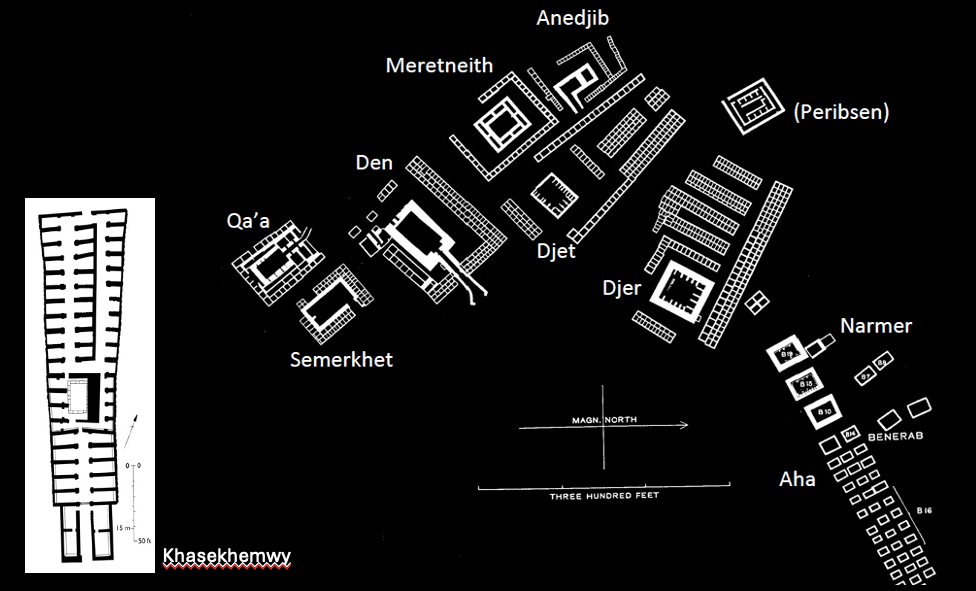
What time period is it from?
Dynasties 1-2
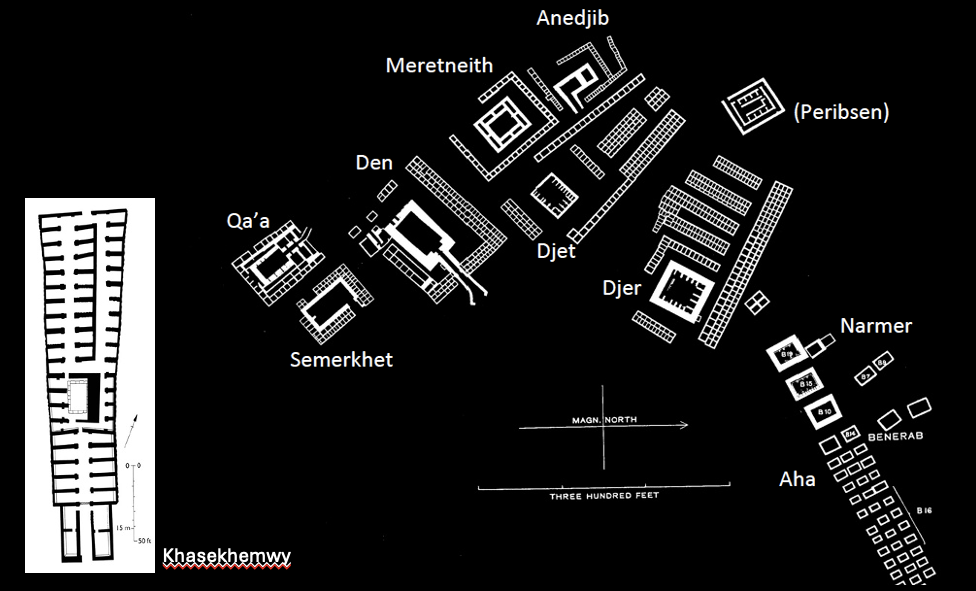
Where is it located?
Abydos
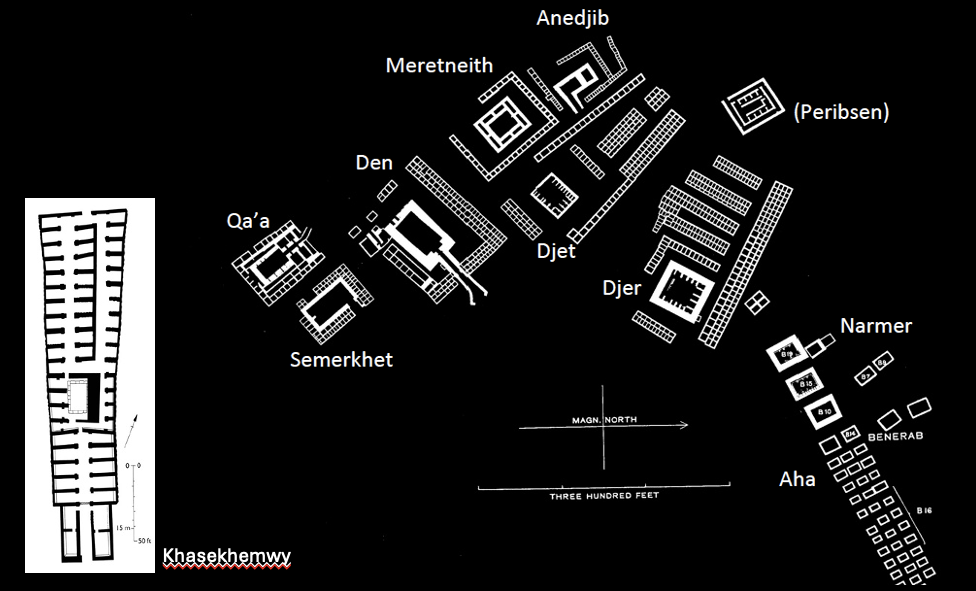
What is its significance?
So some common themes – large mudbrick lined chamber, subsidiary graves that vary in number (we think they are of sacrificed individuals because all covered up and built at once, etc. – but this is once again becoming a debate because of OSL dating) this for the FIRST DYNASTY TOMBS
Riam’s Notes:
“The walls were made out of mudbrick that acts as cement. Some walls have slits were for the spirits of the deceased of the tomb to freely move around. Mimicking the house layouts, There were many wine jars, canpoic jars were used much later on. The jars seem to come from palestine- showing the connection of egypt and other regions at this time. The late kings in egypt hold the crook, the man in abydos had one and if was a king in the period then there would be nothin to corroborate his story. The man buried is for sure wealthy and had status, he had the engraving in his tomb and the crook is found a lt in new kingdom imagery. The mace is the weapon that kings used. The labels in tomb UJ (tags) are pieces of ivory that are carved and there was probably string that went through the hole and attached to something, Really important because its one of the first places that writing started and began. Unable to read the really really really early stag eof this writing, but because the tags are with things it most likey refers to quantities, where it’s from, or what it is.The animals are though to represent locations. And the harder to read symbols is most likey what it is.”
Other Student: “Tombs of the first and some of the second dynastic pharaohs. Evidence that people returned to the sight over and over again. All tombs share the same basic structure.
Cemetery U: Includes famous tomb U-j which belonged to a powerful ruler. Tomb includes inscribed tablets which contain, what is believed to be, the oldest known example of writing. Along with pieces of ivory.
Cemetery B: Exclusively used by the royal family. Tombs were significantly larger which indicate increase in wealth.”
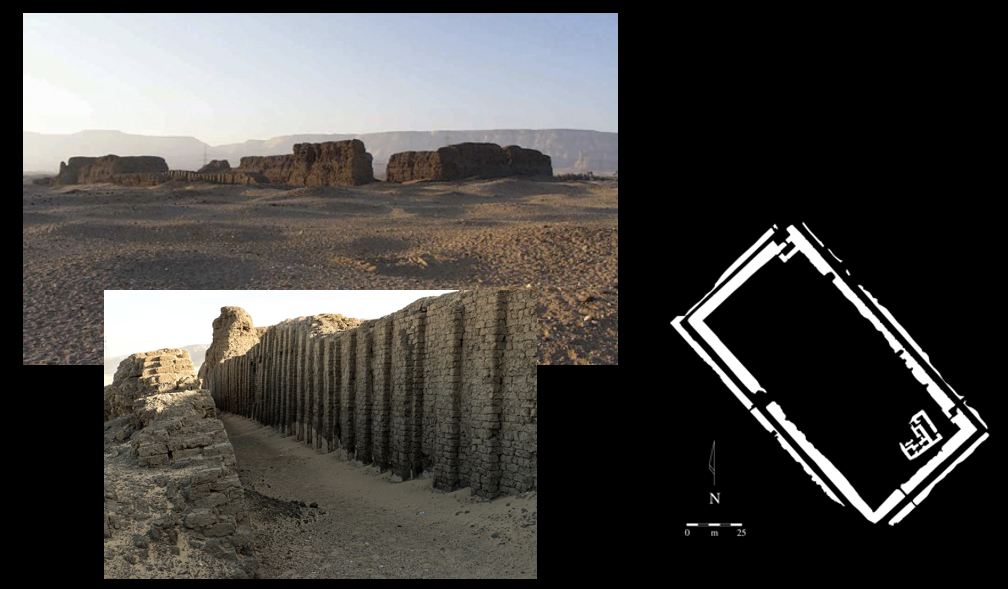
What is this?
Funerary enclosure” of Khasekhemwy

What is it made of?
Mudbrick
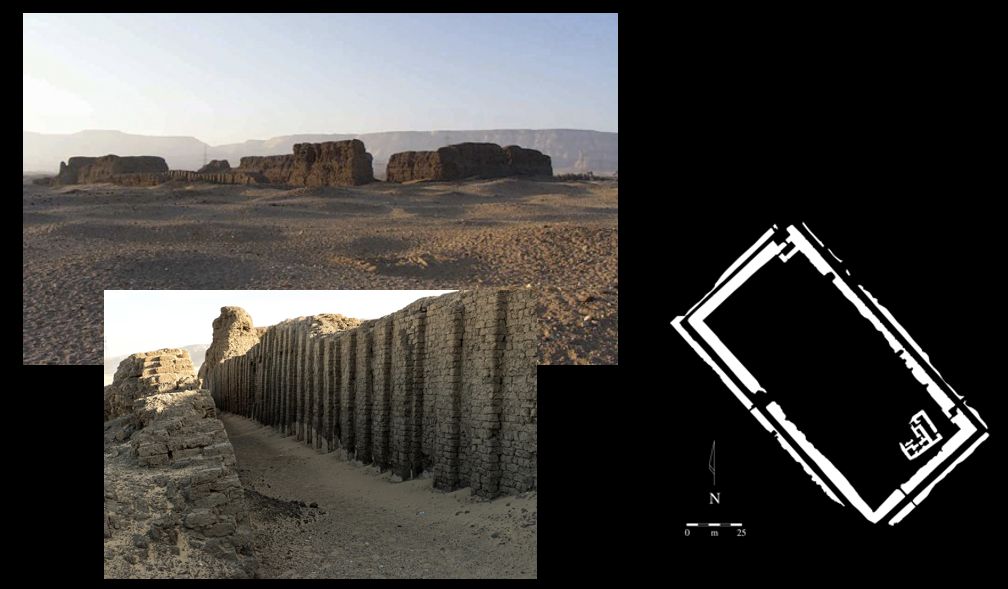
What time period is it from?
Second Dynasty
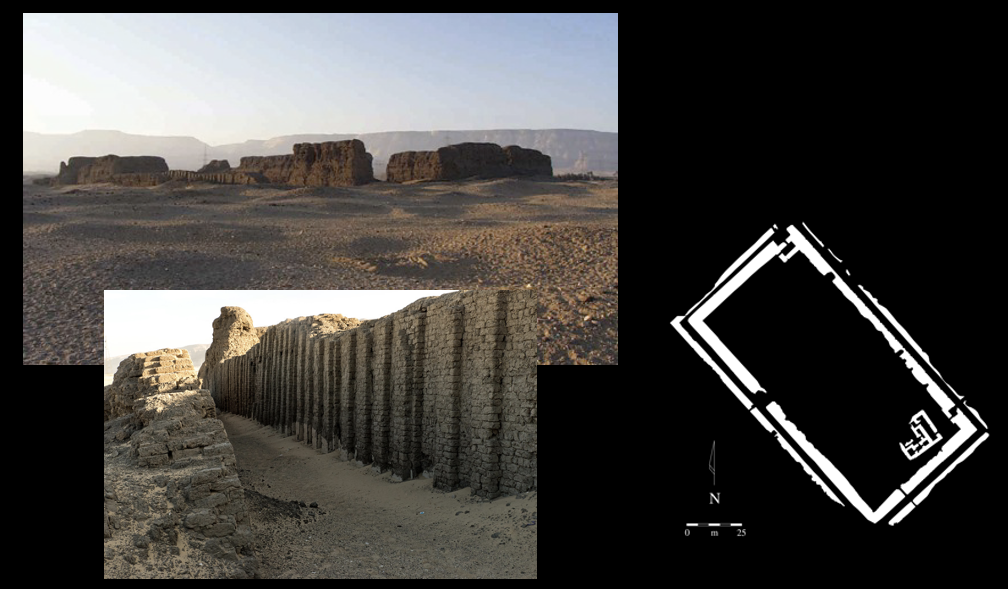
Where is it found?
Abydos
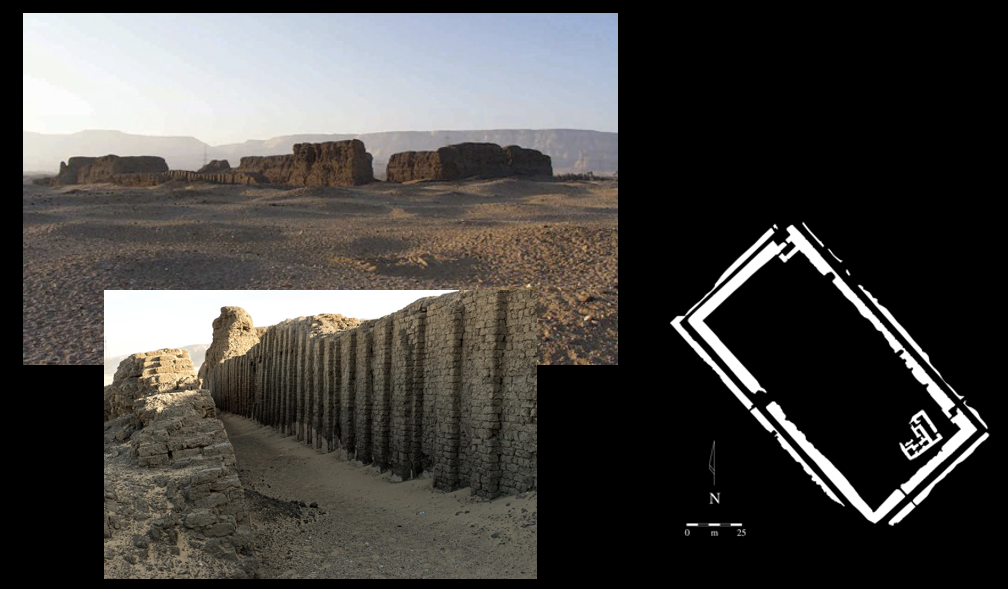
What is its significance?
It seems like Narmer had the first one (a dating based on ceramics rather than inscriptions). Khasekhemwy’s (of the Second Dynasty) is the only one that still stands today
Usual layout: niched brick enclosure, two doors (one of which was usually bricked up and does not seem to have been used, the E one was the main one) and what seem to have been cultic buildings inside
Riam’s Notes: “Funerary enclosures are a misnomer, thought they were related to funerary practices but seems like that wasn't the case. Usually mudbrick walls
Funerary enclose of Kasekhemwy is the only one that survived and seems like the funerary enclosures were used during the lives of these kings, there is a lot of evidence inside the monuments where offering were brought during the lives of these kings, some had small structures inside and seems like once that king dies then that monument was destroyed. In abydos.
Some of the enclosures had boat graves associated with them, has the boat outline in brick and the wood in the middle where the brick was built around it. Unsure why they’re in the grave, an idea is that its for the journey into the afterlife.”
Other Student: “One of Egypt’s oldest standing royal monuments and one of the oldest preserved mudbrick buildings. Shows the earlier stages of the evolution of pyramids.”
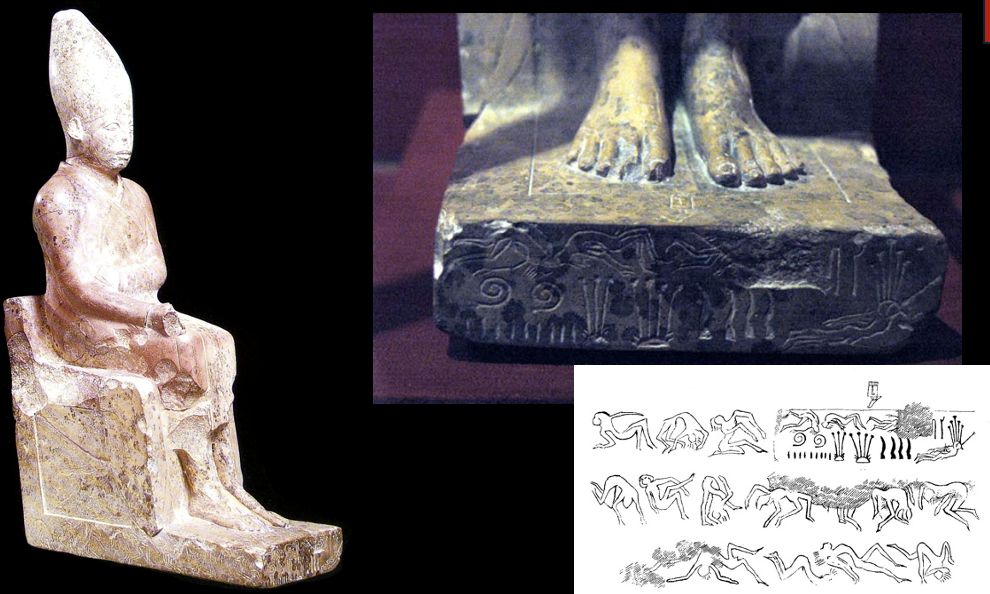
What is this?
Statue of Khasekhemwy
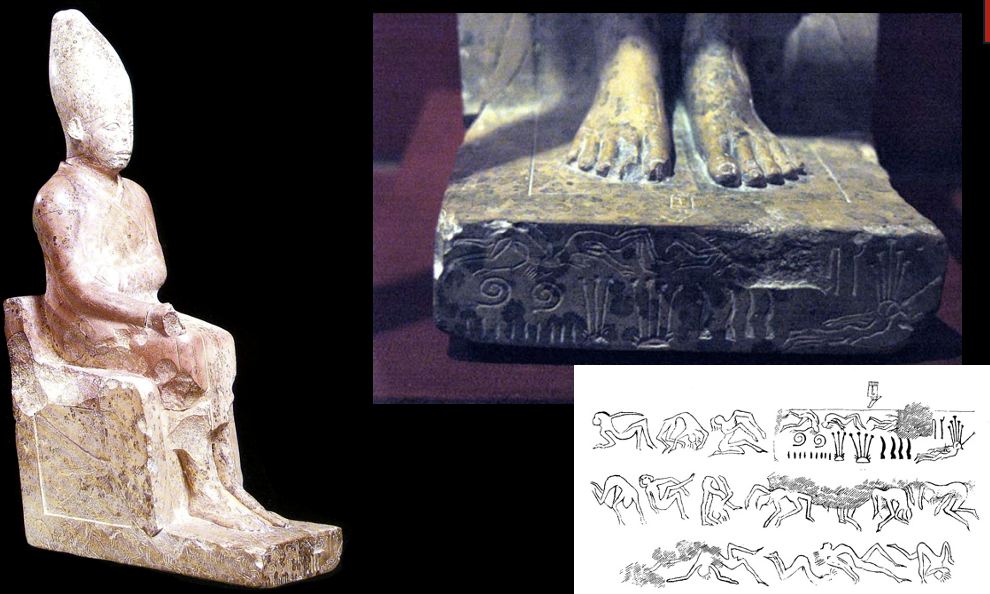
What is it made of?
Limestone
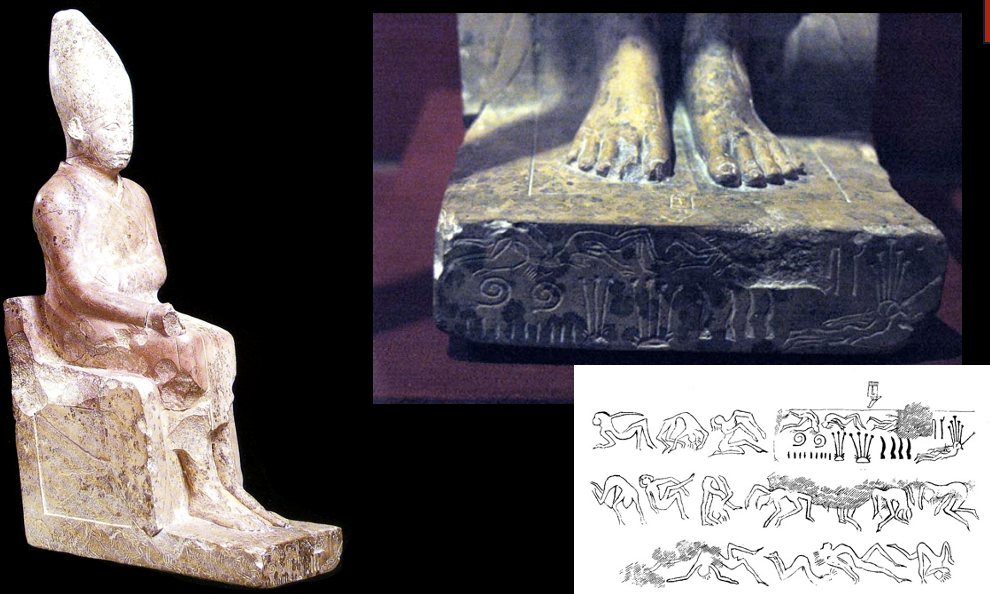
What time period is it from?
Second Dynasty
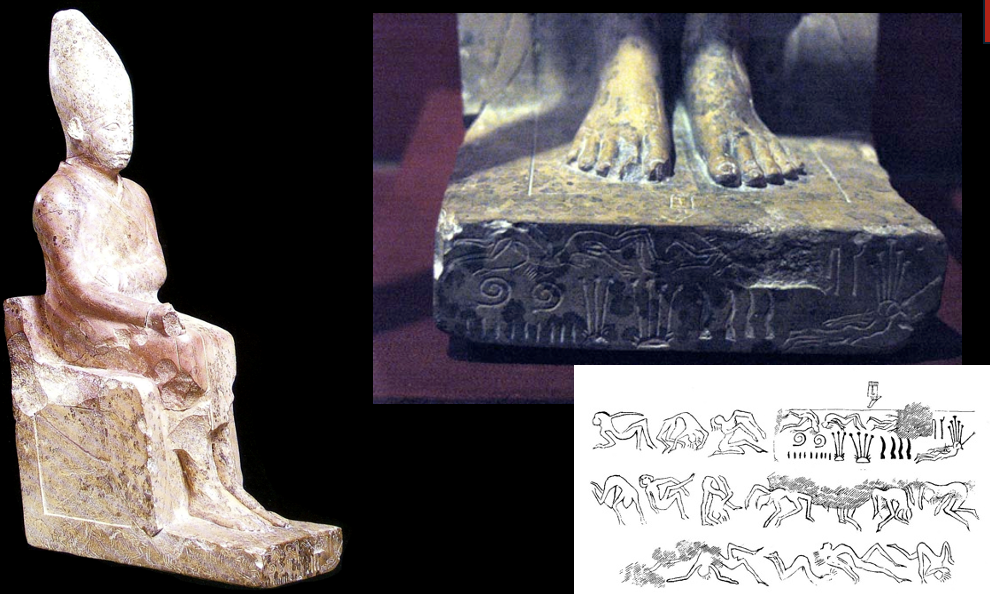
Where is it found?
Hierakonpolis
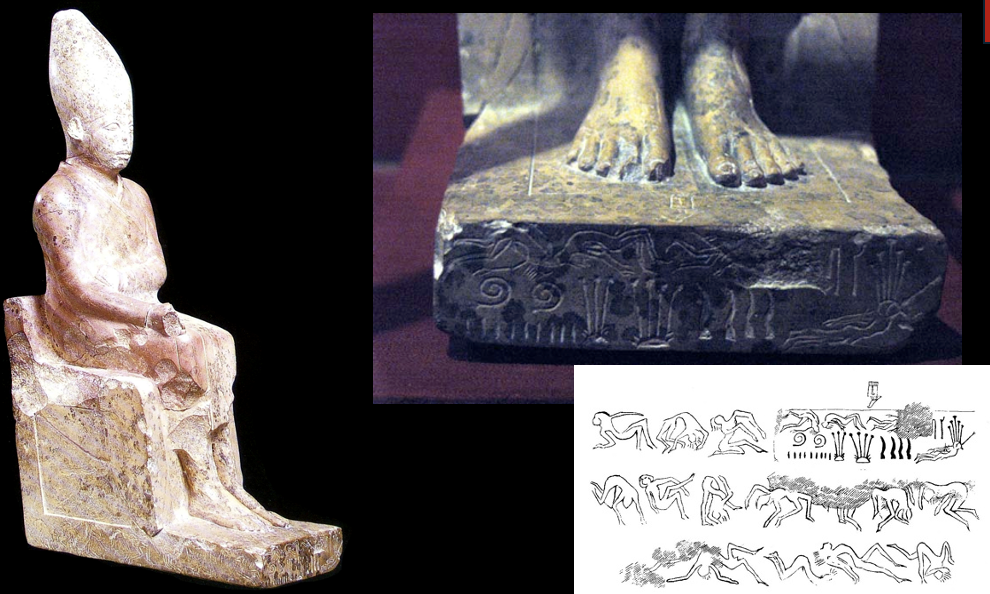
What is its significance?
Statue from Khasekhemwy with inscription mentioning that he had smote northerners (hey look some more swimming dead people) – is found elsewhere in his reign too, not just this statue
Mention insane numbers in here (don’t trust Egyptian numbers children)
Riam’s Notes:
“Khasekhemwy had the (used the Horus and seth) He beat Peribsen and his name meant the “two powers have appeared", the images of the horus and seth indicated the unification of Upper and Lower Egypt
Khasekhemwy had an image at the base of his statue that had dead people and with the number 20,000, indicating that Kasekhemwy is making a point in winning the conflict and is using the numbers to tell it.”
Other student: “King Khasekhemwy, the last king of the 2nd Dynasty. He is wearing the crown of Upper Egypt and has the symbols of both Horus and Seth on his serekh. The inscription on its base is proof of documentation of a number of enemies killed in battle against the northerners.”
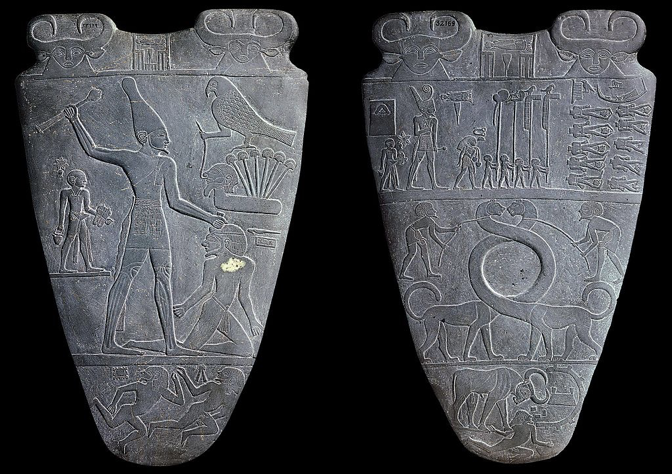
What is this?
Narmer Palette

What is it made of?
Greywacke
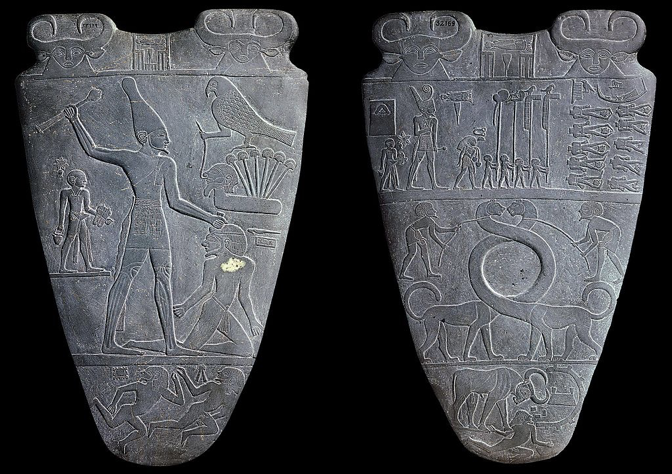
What time period is it from?
Dynasty 1
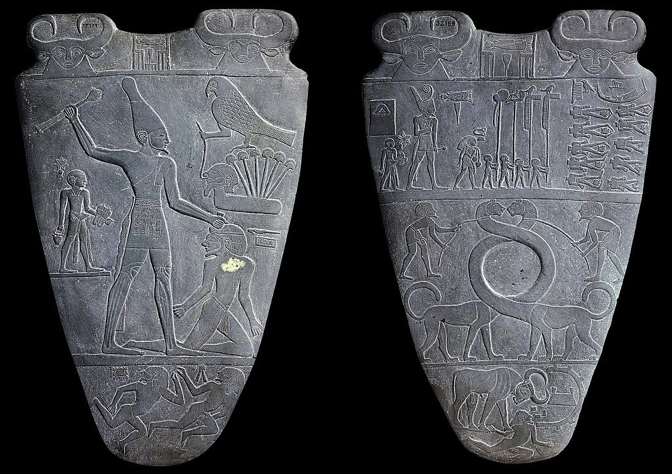
Where is it found?
Hierakonpolis
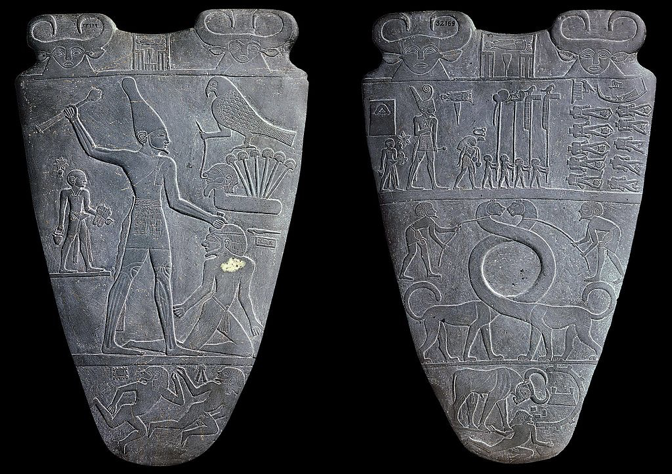
What is its significance?
Riam’s Notes:
“Decapitated prisoners who were tied up in front of the king. Between the king and the decapitated people were people who we assume to represent the gods. Outline of a settlement or city and a bull destroying it, with dead people at the bottom. There are kings and a lot of dead people.
The Narmer Palette represents conflict and violence that the big king is smiting someone and was read in early Eygpt archeology as a document of the early unification of Egypt. Narmer was named in several areas of the stone, at the top the symbols spell out Narmer and there is an area where Narmer is low on the stone and is below the god Horus.
Narmer is coming from the south and smiting someone from the North. Other side there is a Narmer with a lower crown smiting someone with a upper crown.
Telling us Narmer, who is a king from Lower Egypt and conquered Upper Egypt. But this was an early representation of the stone piece.”
Other student: “Narmer’s name is shown at the center top inscription. Narmer is seen twice the size of other people (suggesting his power) and “smiting” enemies. Narmer is also wearing the crown of Upper Egypt. Horus is also featured, holding the rope that is holding a severed head. On the other side, Narmer wears the crown of Lower Egypt so it could represent a unification of Upper and Lower Egypt.”
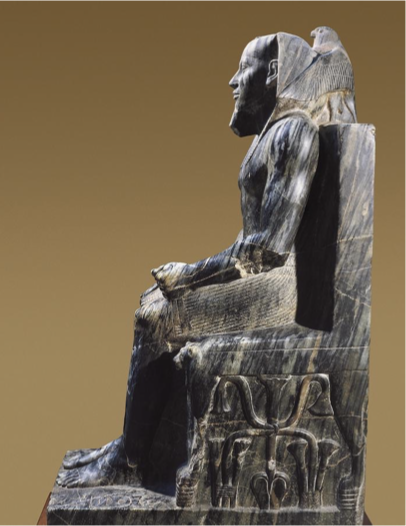
What is this?
Khafre and Horus statue (“Khafre Enthroned”)
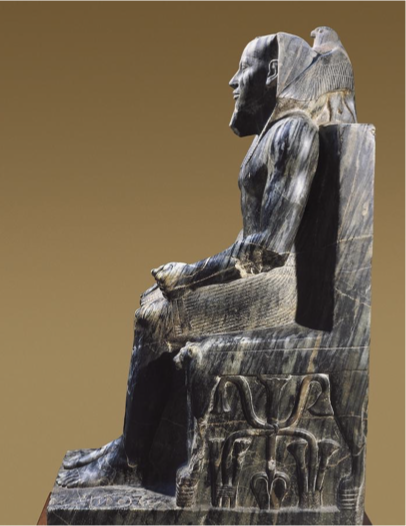
What is it made of?
Gneiss (black stone)
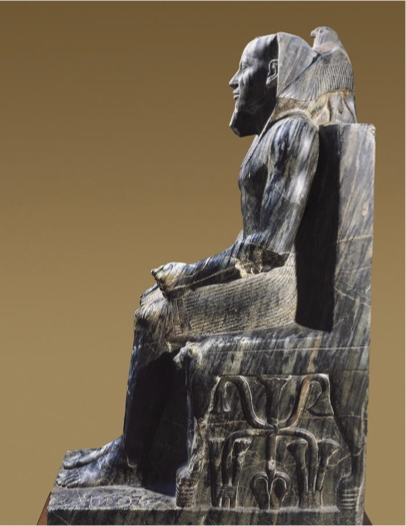
Where is it found?
Giza
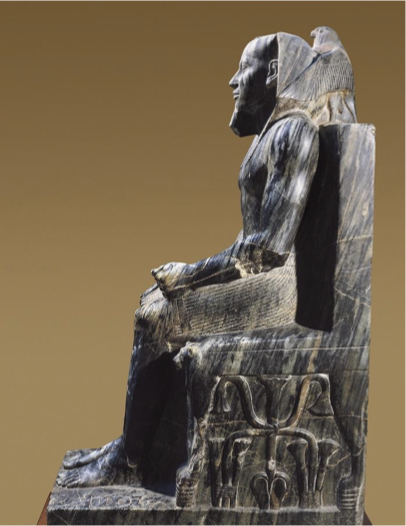
What time period is it from?
Fourth Dynasty
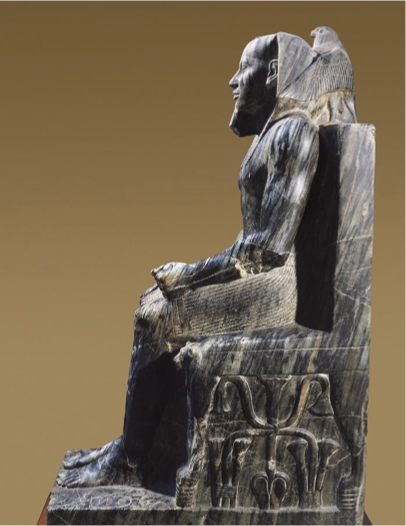
What is its significance?
Riam’s Notes:
“Khafre and Horus Statue (“Khafre Enthroned”)
He has the headdress, Horus, and the kilt, which represent the king
The king is a lot bigger than the Horus, and the Horus (God) is in an insubordinate position to the king.
Sema tawy is engraved at the bottom, meaning the unification of the upper and lower Egypt.
A fake long beard that looks like a long chin also shows status
A headdress is only worn by a king.
Dynasty 4 is the most well-known and is when the pyramids were built.”
Other student: “King Khafre is shown wearing the royal headdress and a false beard with a cubic throne, all signs of royalty. The addition of Horus shows King Khafre’s connection to the gods. On the front of him,”
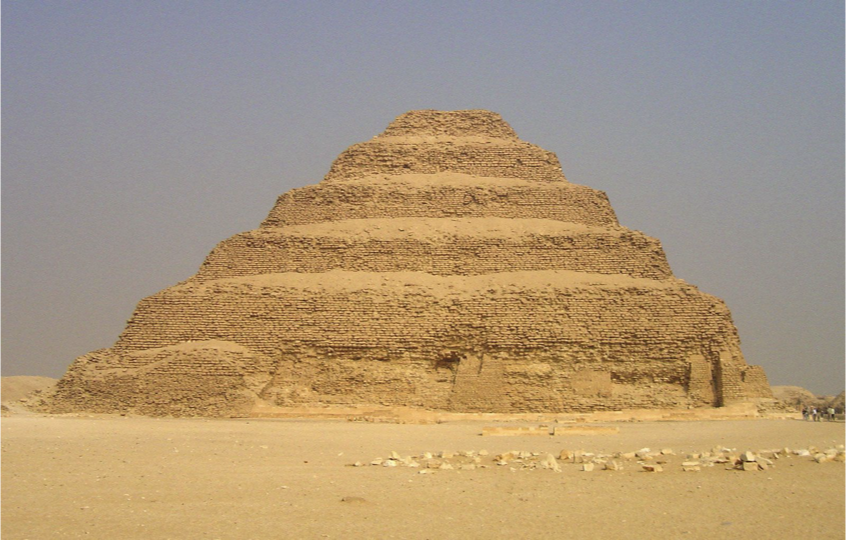
What is this?
Step Pyramid of Djoser
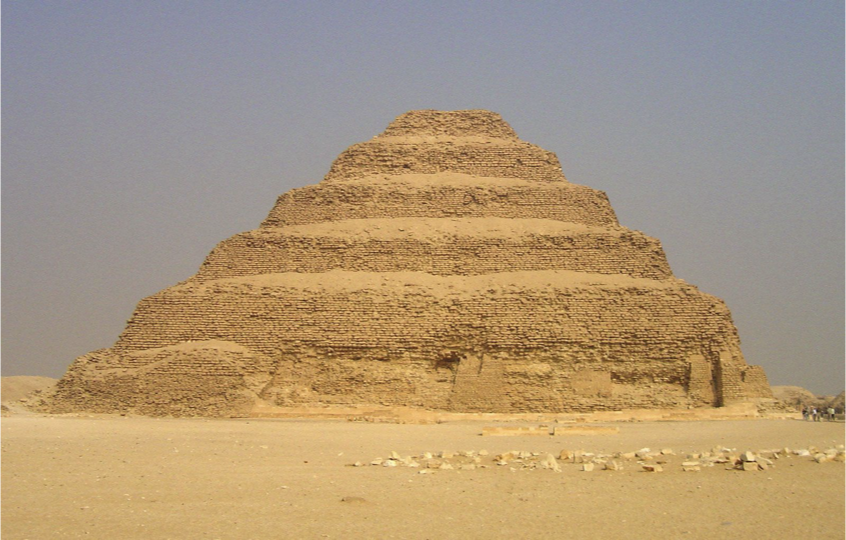
What is it made of?
Stone
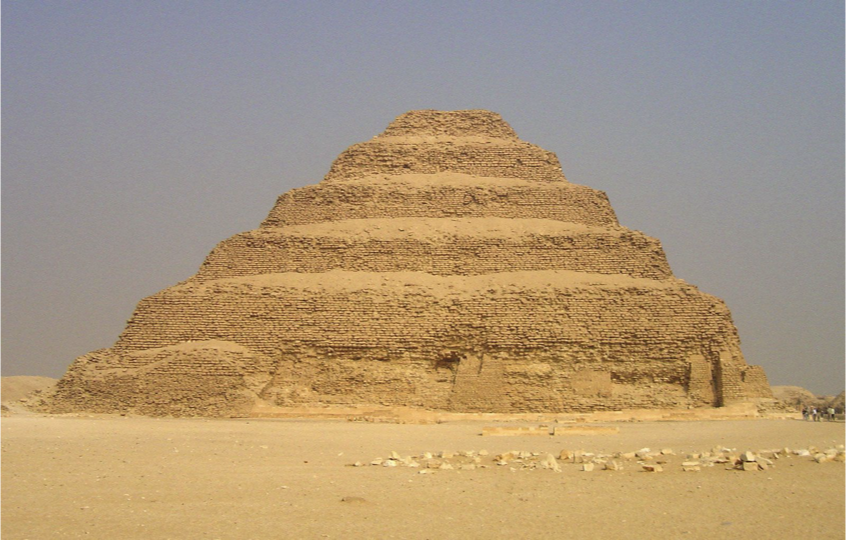
Where is it found?
Saqqara
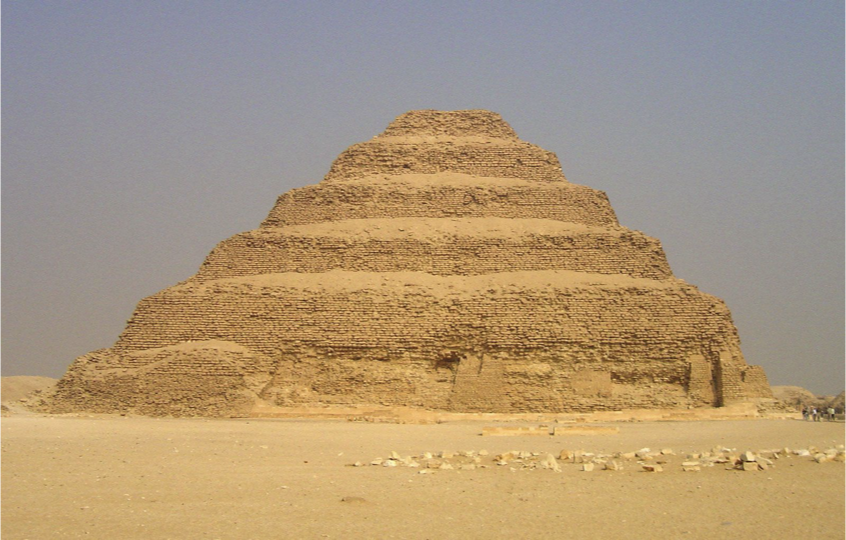
What time period is it from?
Third Dynasty
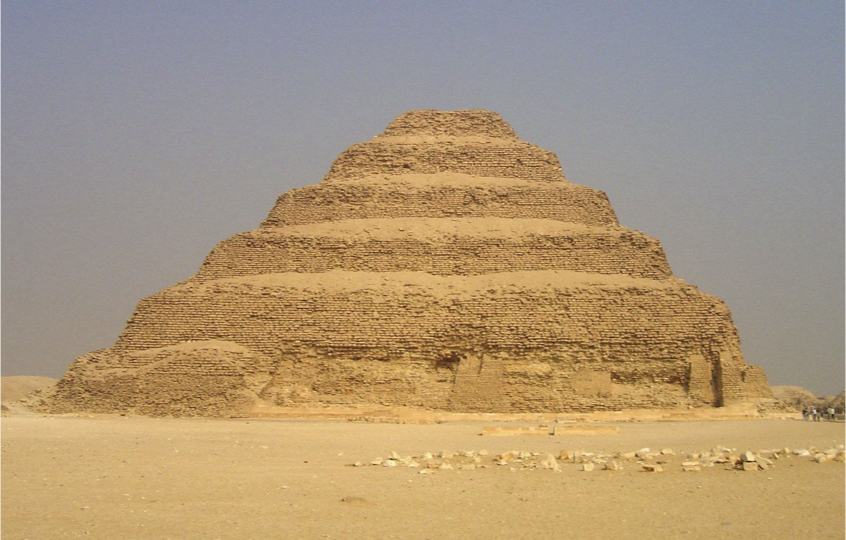
What is its significance?
Starting with Djoser
Riam’s Notes:
"Built on top of a Mastaba, it’s shape is unlike the others and was the first pyramid built, showing how the pyramid was originally designed and shows how the later pyramids made it better.
First and oldest stone building in Egypt.
Held statues of Egyptian Gods and of Djoser and his family. It is the oldest important stone building in Egypt as well as the center of a large mortuary complex in Saqqara.”
Other student: “Held statues of Egyptian Gods and of Djoser and his family. It is the oldest important stone building in Egypt as well as the center of a large mortuary complex in Saqqara.”
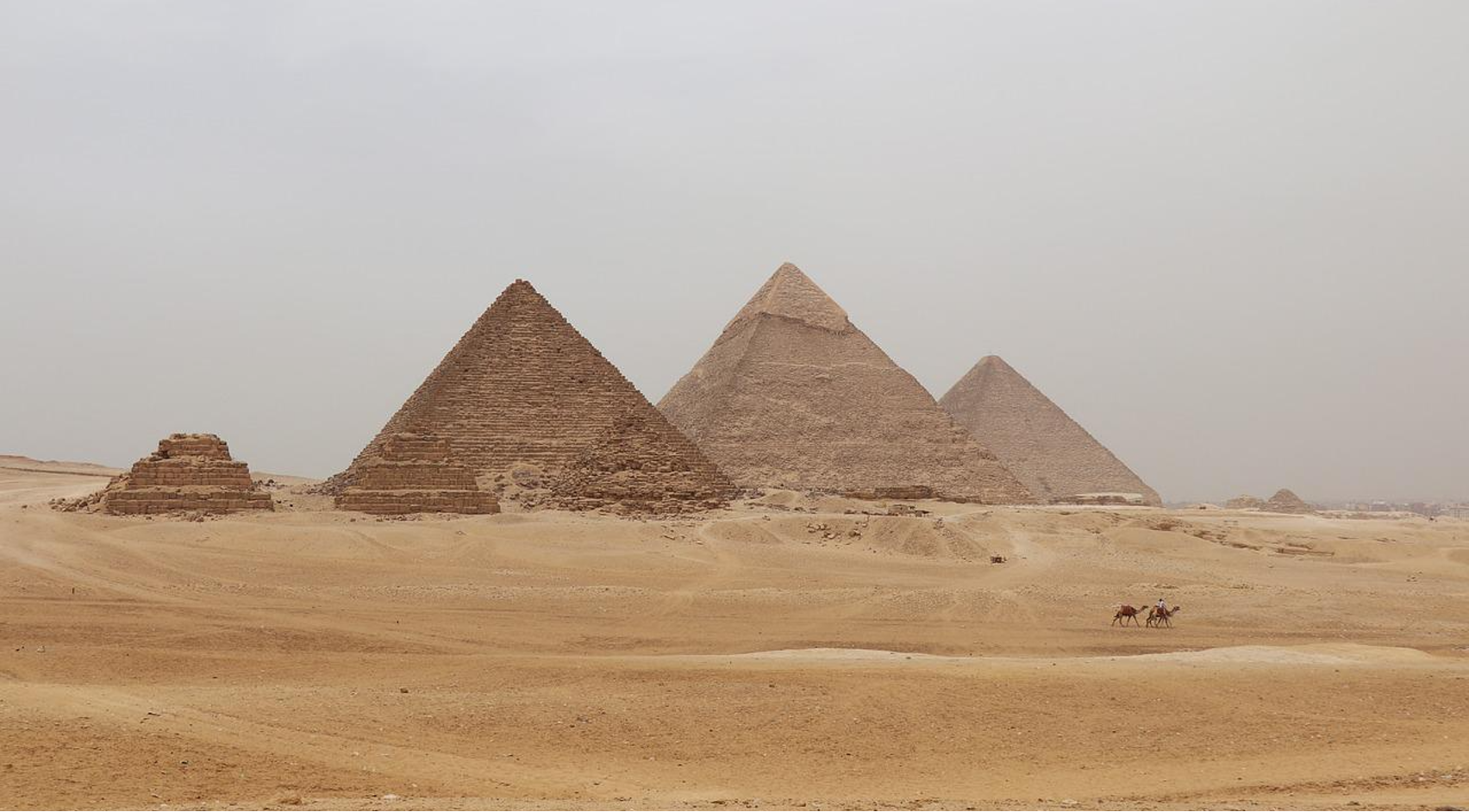
What is this?
Giza Pyramids
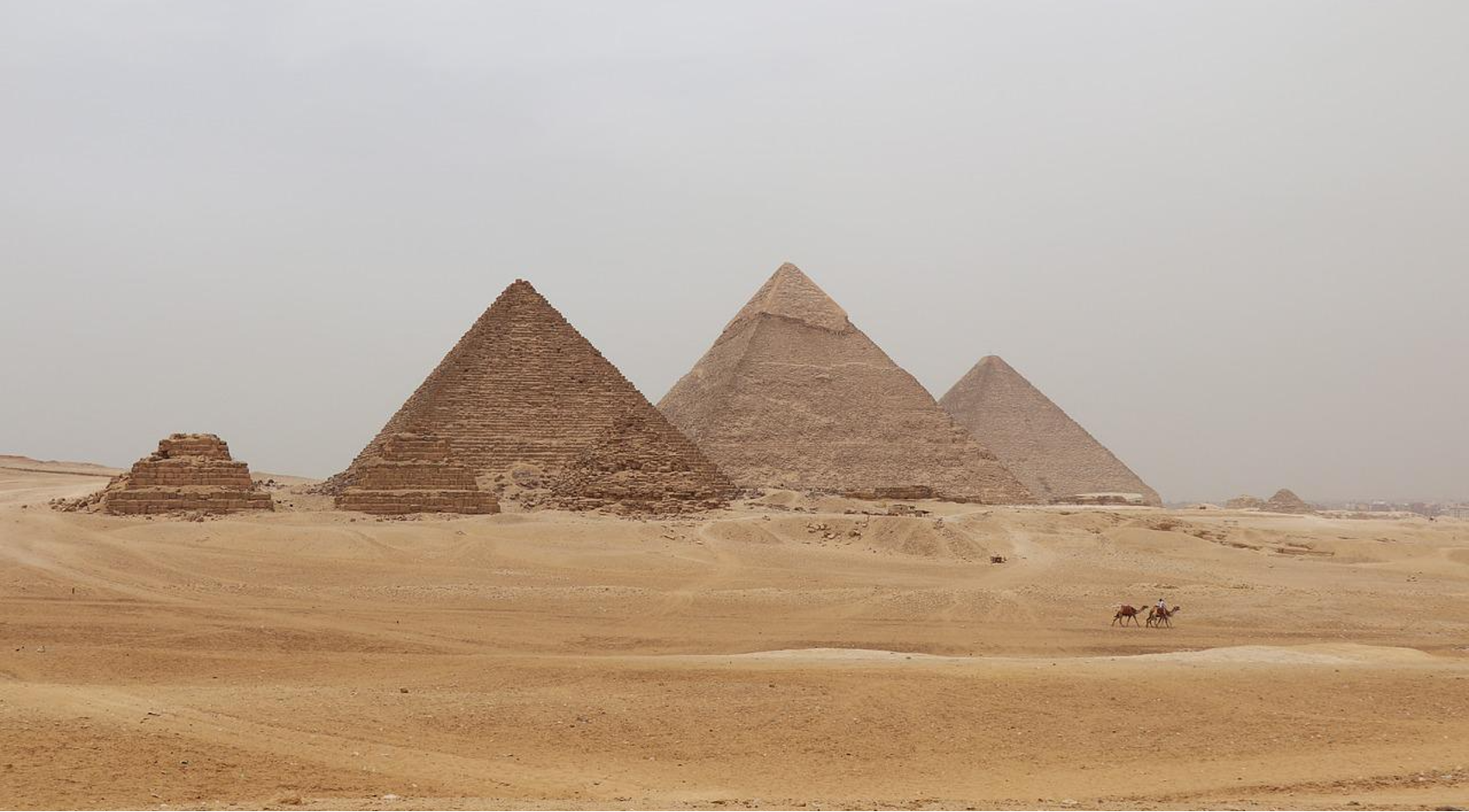
What time period is it from?
Fourth Dynasty
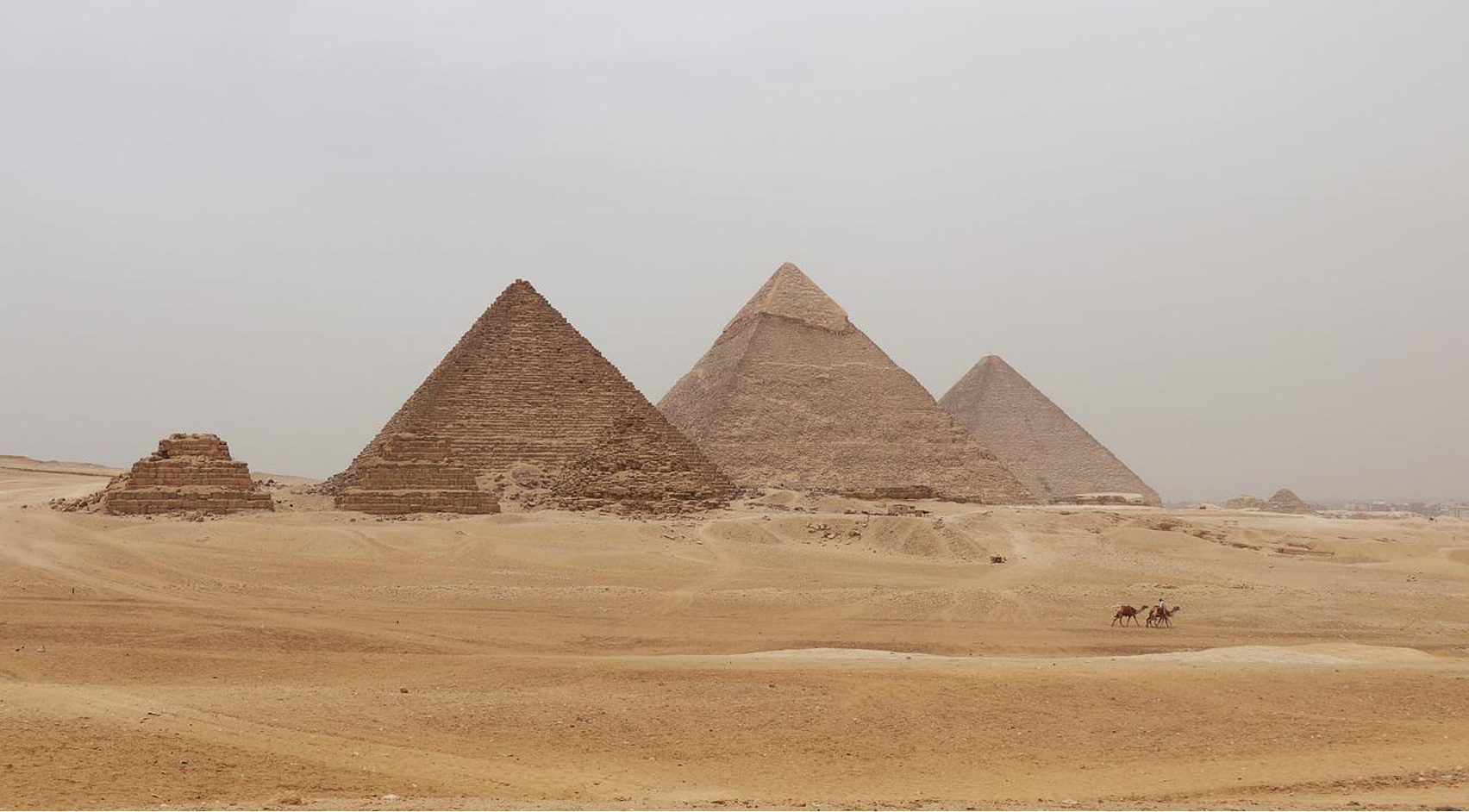
What is it made of?
Built of stone
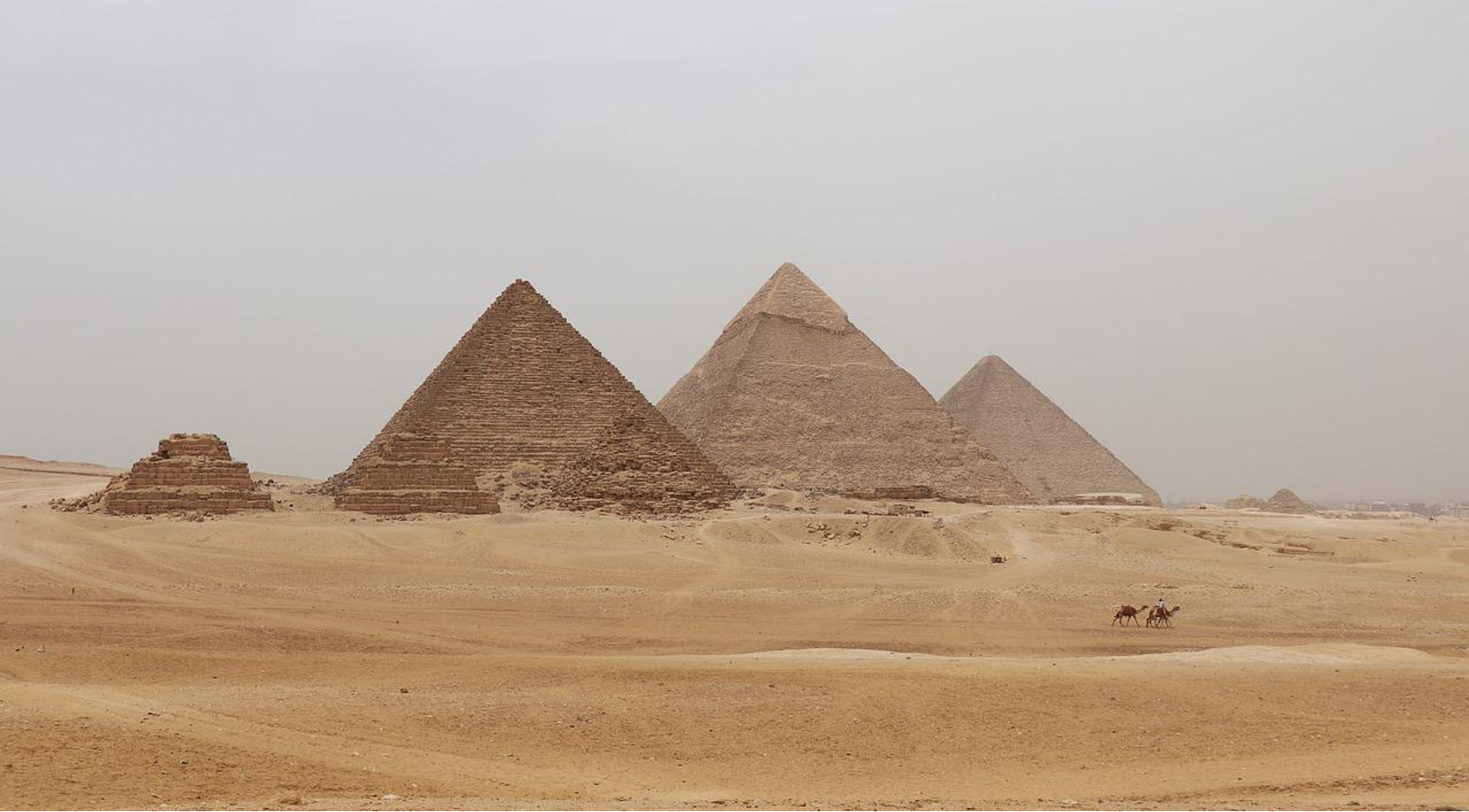
What is its significance?
Riam’s Notes:
“The Giza plateau with pyramid complexes, like the step pyramid, it’s not just the pyramid, its a complex
Linear alignment: pyramid → funerary temple → causeway → valley temple (east–west orientation).
Pyramid, temple, valley temple, sphinx, offerings at the mortuary temple
All the rectangles by the Giza plateau are royal official tombs.”
Other student: “They were built for three different pharaohs: Khufu, Khafre, and Menkaure. Each pyramid is a burial chamber, but is also seen as a reference to the sun, as pyramids were viewed as a place of regeneration for the deceased ruler.”
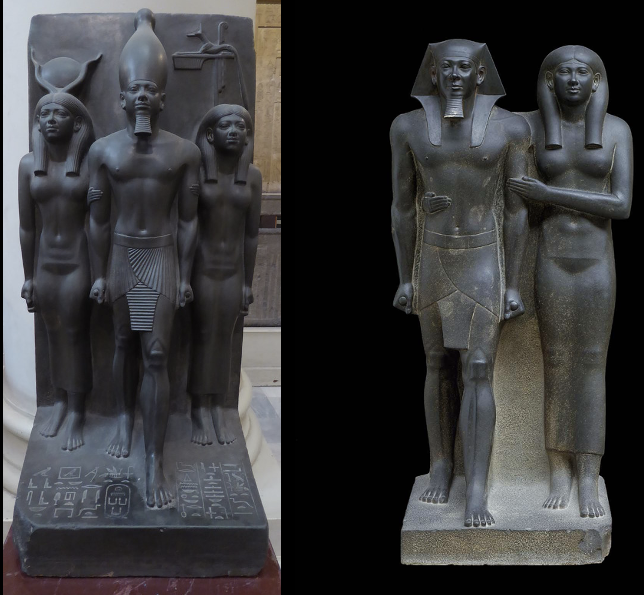
What is this?
Menkaure triad or Menkaure and queen
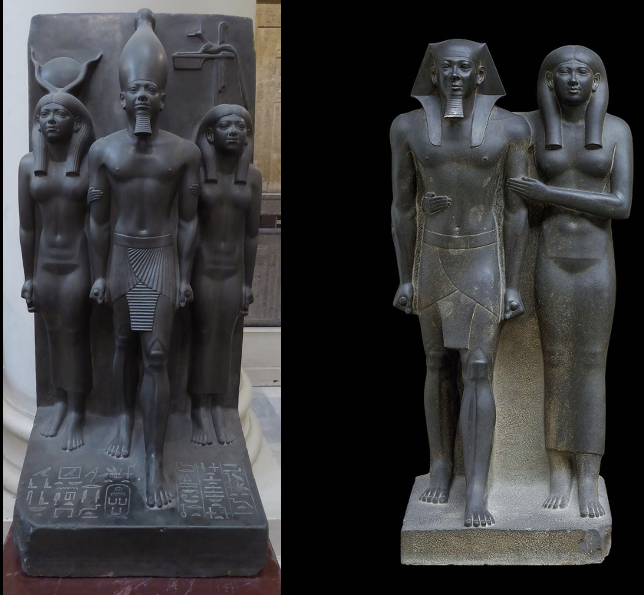
What is it made of?
Greywacke (black stone)
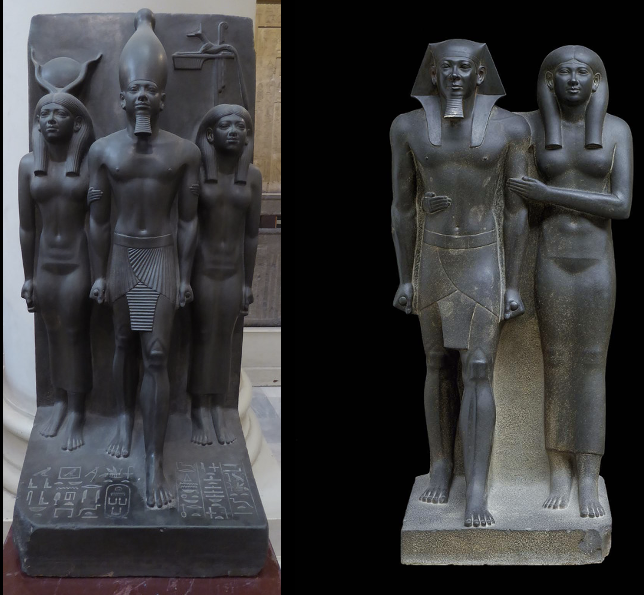
Where is it found?
Menkaure valley temple, Giza
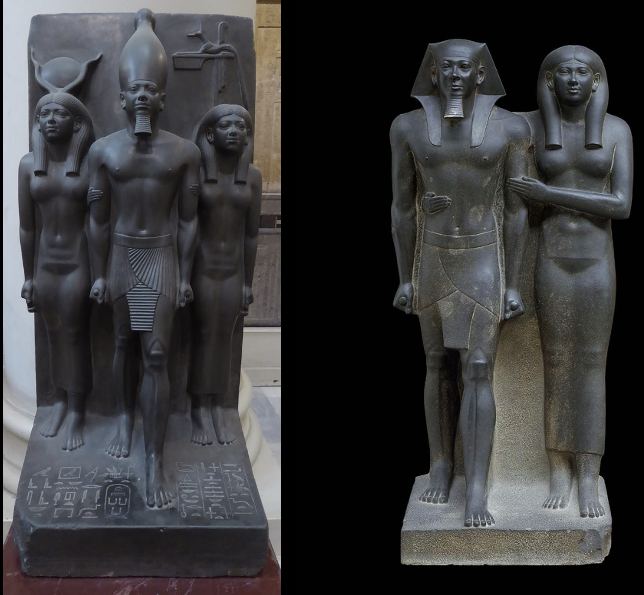
What time period is it from?
Fourth Dynasty
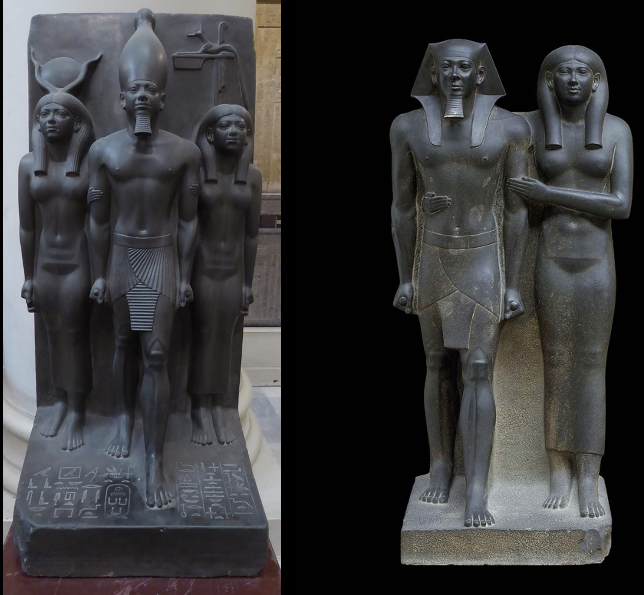
What is its significance?
Although Reisner believed that there were several dozen triads, one for each nome, a recent interpretation is that there were originally 8 group sculptures symbolizing major sites associated with the cult of Hathor.
Hathor dominates group, central and forward position, guardian of the necropolis and protector of the king, block seat and rectangular slab in the back, Hathor’s left arm embraces Menkaura’s waist right arm rests on king’s arm (pose?) round face, subtle modeling of eyebrows, folds on the upper eyelids, chin recedes slightly, solar disc and cow horns, prominently displayed incised tripartite wig, sleeveless dress, wesekh broad collar with teardrop pendant and wide bracelet hardly visible. King: shendyt kilt with belt, painted neck ornament in form of a multistrand beaded collar and pair of bracelets once completed the look. Inscription on the base: The Horus Kakhet, King of Upper and Lower Egypt, Menkaure, beloved of Hathor, Mistress of the Sycamore. Recitation - I have given you all good things, all offerings and provisions in Upper Egypt forever’.
Other student: “The first picture shows Menkaure wearing a crown of Upper Egypt in between Hathor and the personification of nomoi. All three statues are taking steps forward hinting at the power each figure holds.
The second picture shows both Menkaure and his wife, both taking a step forward. Menkaure is has a bigger stride showing his power while his wife also has more power than is usual for a woman, showing how she is powerful for her time.”
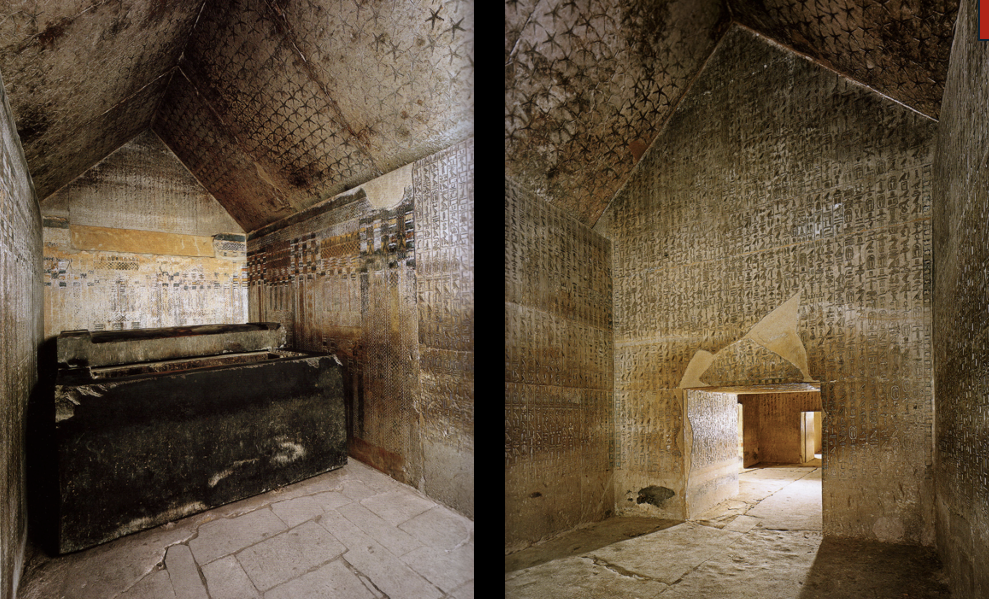
What is this?
Unas’ burial chamber
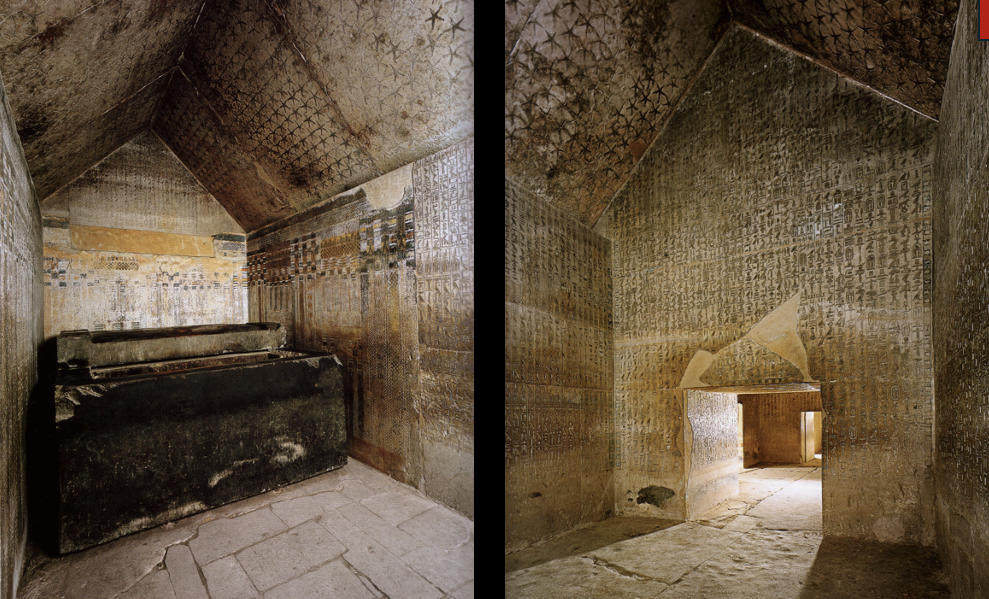
What is it made of?
Carvings and paint on limestone walls

What time period is it from?
Fifth Dynasty
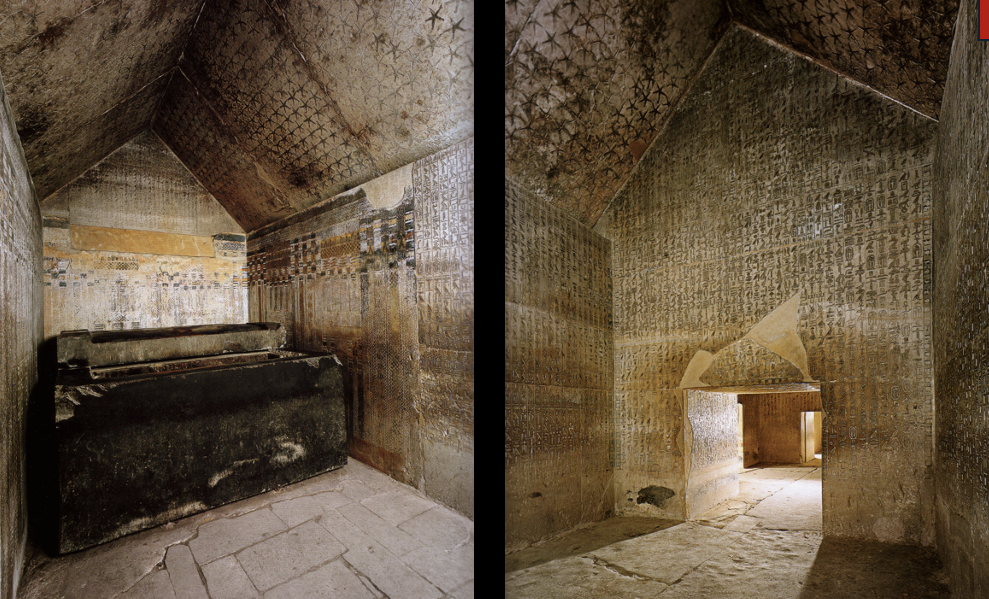
Where is it found?
Saqqara
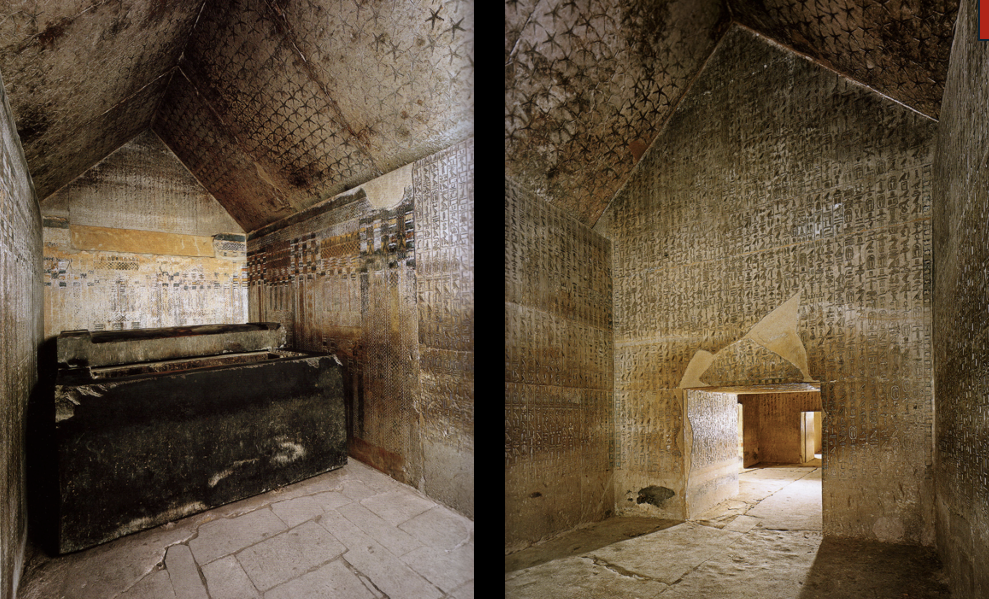
What is its significance?
Those decorations were never in the burial chamber; those started being decorated in Unas’ reign, but with Pyramid Texts rather than extension scenes
Riam’s Notes:
“Everything was done to help guide the king in the afterlife”
Other student: “Had the first known inscribed texts on the walls of the burial chamber that guided the deceased pharaoh”
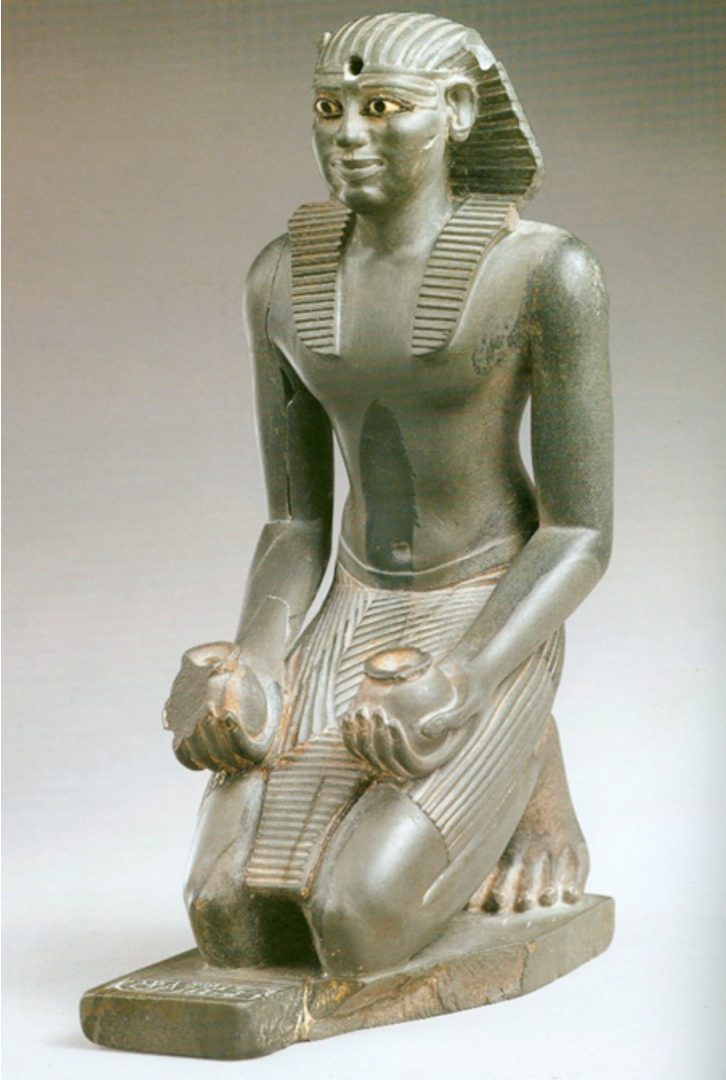
What is this?
Statue of Pepy I
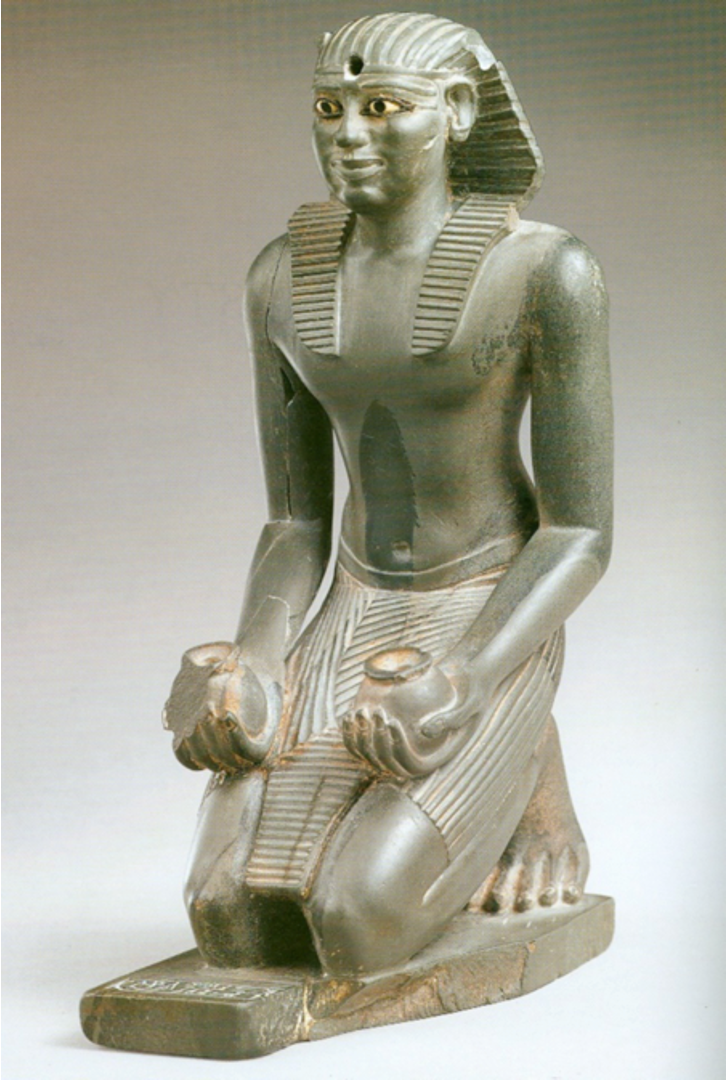
What is it made of?
Greywacke
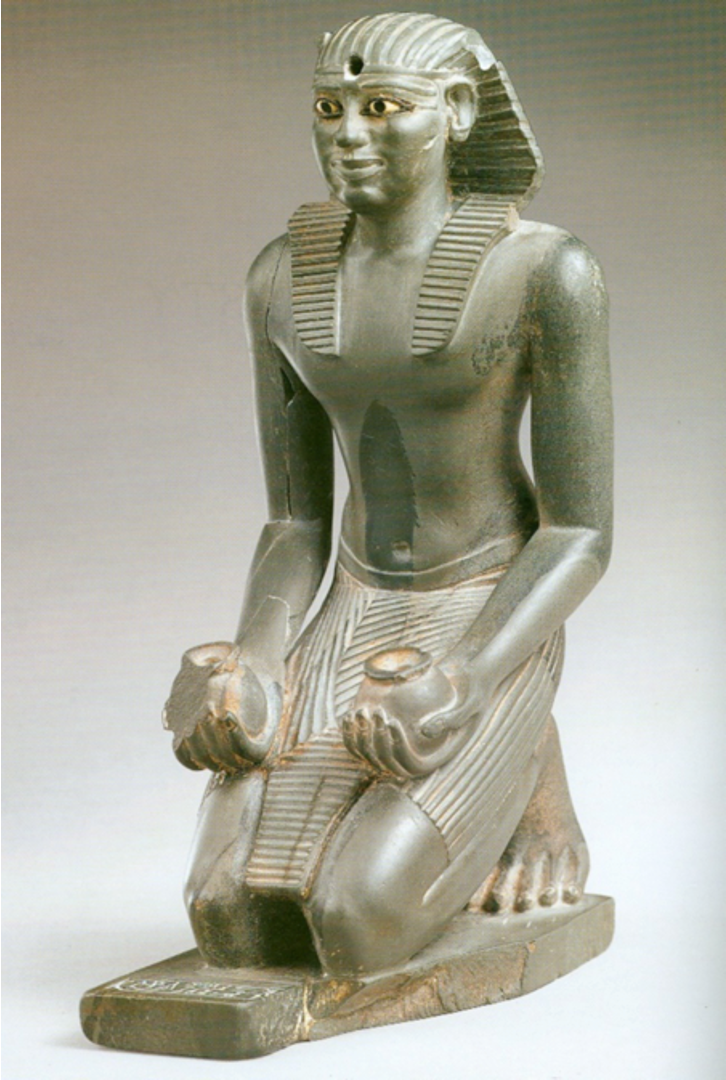
Where is it found?
Unknown location (likely a divine temple)

What time period is it from?
Sixth Dynasty
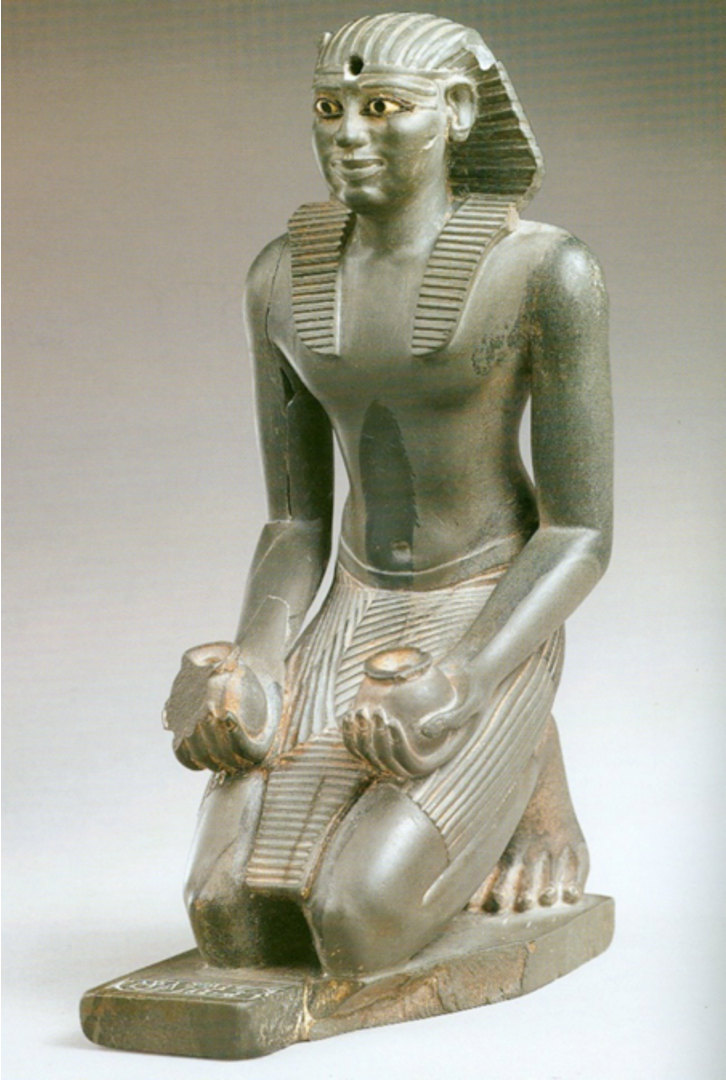
What is its significance?
King offering nu pots, stands for the rise of provincial temples and the (supposed) increased visibility/presence of kingship in local contexts
Serekh statue
Riam’s Notes: “Shows a major switch in how gods were worshipped.”
Other student: “The object shows how King Pepi i is kneeling to bring offerings to the gods. Kings only ever kneeled for gods because of their “divine status” as pharaoh”
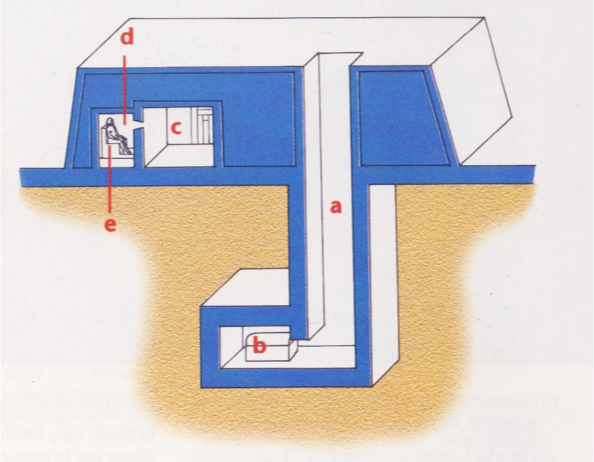
What is this?
Old Kingdom private tomb form: Mastaba
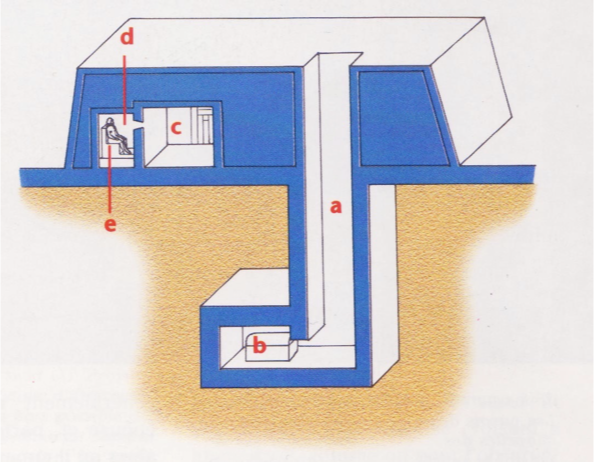
What is it made of?
Built of stone
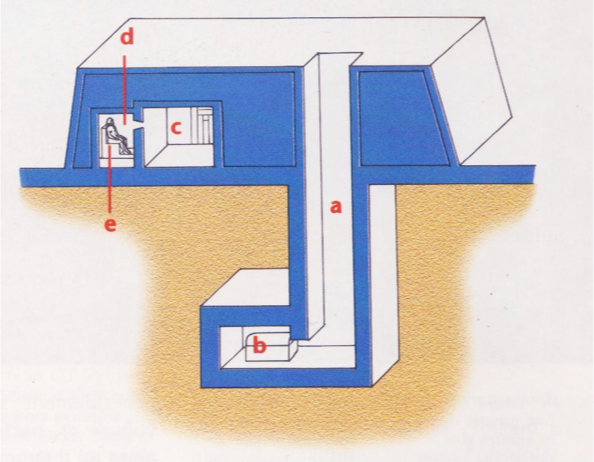
What time period is it from?
Often built in cemeteries associated with royal monuments in the 4th Dynasty, in the later Old Kingdom found elsewhere in Egypt
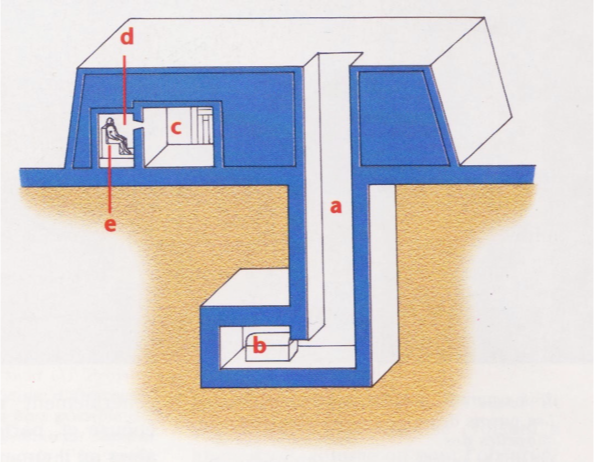
What are the components?
Different components
A: burial shaft
B: burial chamber
C: chapel
D: serdab
E: statue
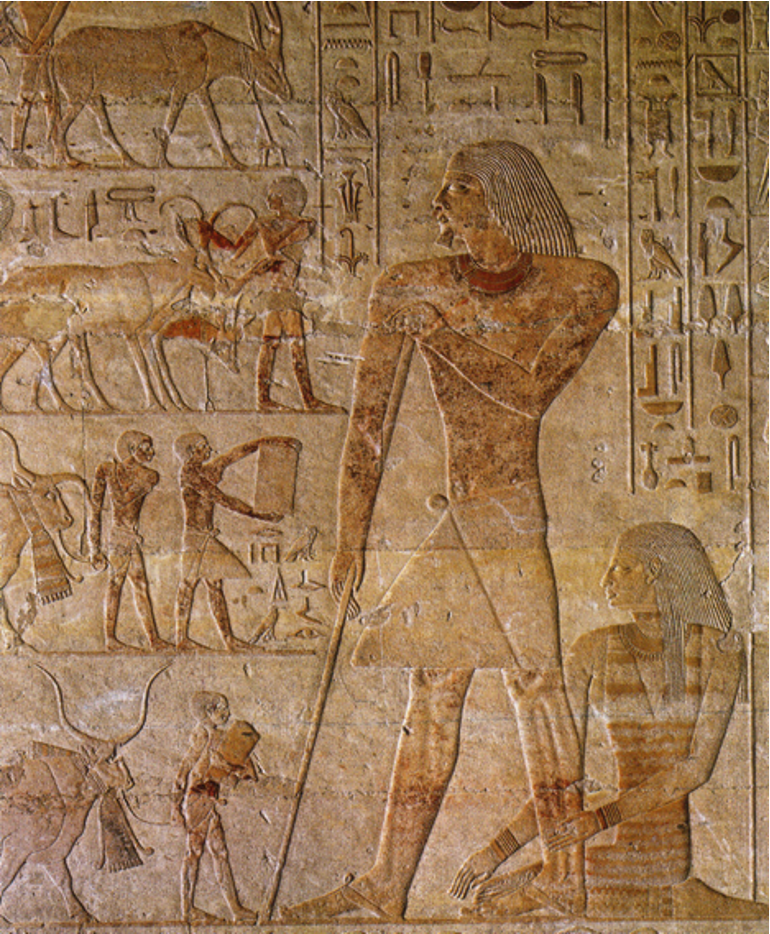
What is this?
Wall painting
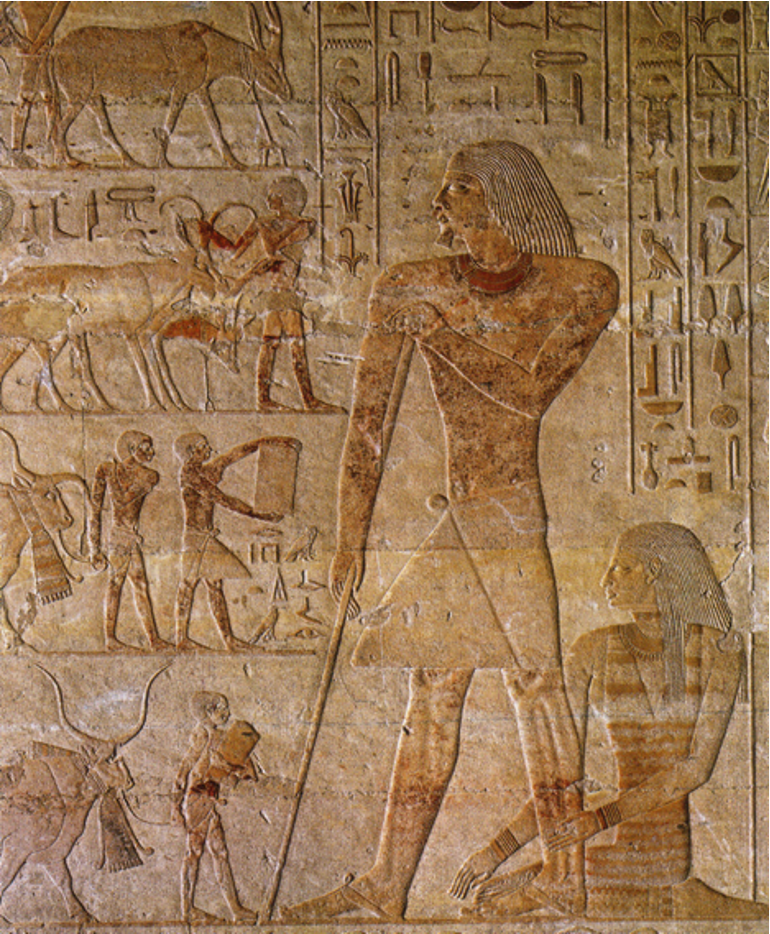
Where is it found?
Mastaba of Ti, Saqqara
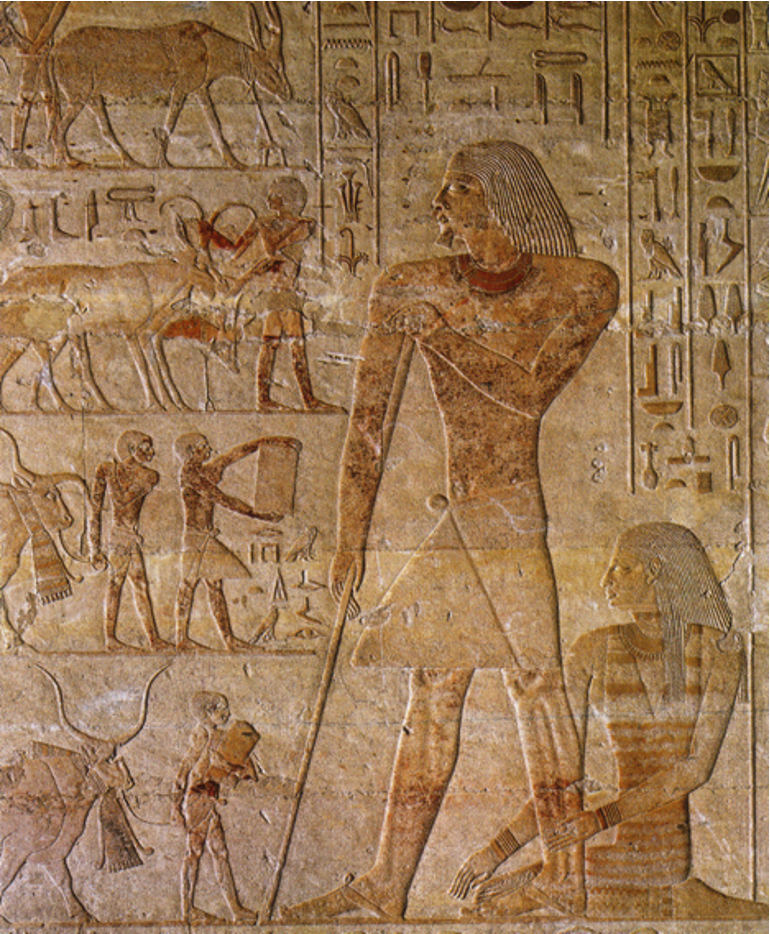
What time period is it from?
Fifth Dynasty

What is its significance?
Or like in the mastaba of Ti, where a serdab existed (remember serdabs y’all?)
Also mention height of Ti here, matter of scale = status
Riam’s Notes:
“By having the big man in his tomb shows status, has naked people and naked people are lower status.”
Other Student: “Used as a primary source about daily life and beliefs during the Old Kingdom. The scenes depict Ti and his wife as the biggest figures, highlighting who the scene is about. His wife is also a bigger figure but is kneeling, while Ti is standing, showing his importance and power. The other figures are doing what looks to be farmwork, which indicates that Ti and his wife have positions such as royal overseer and priestess/”royal acquaintance”"
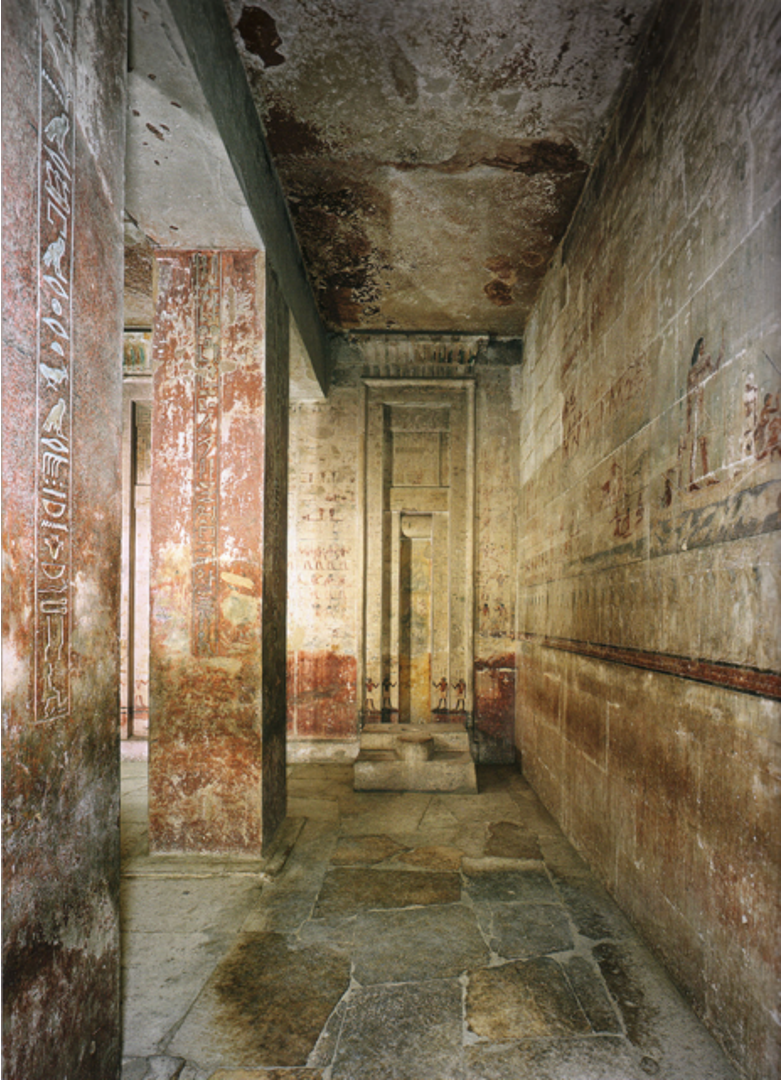
What is this?
False door
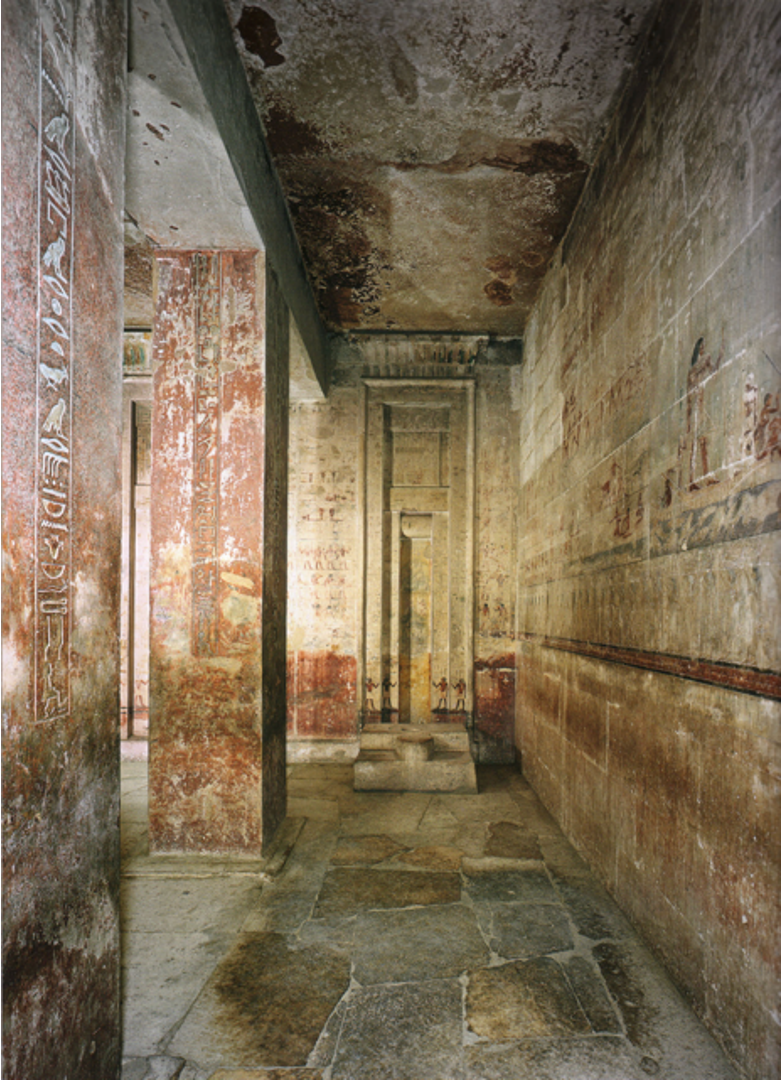
What is it made of?
Carvings and paint on stone
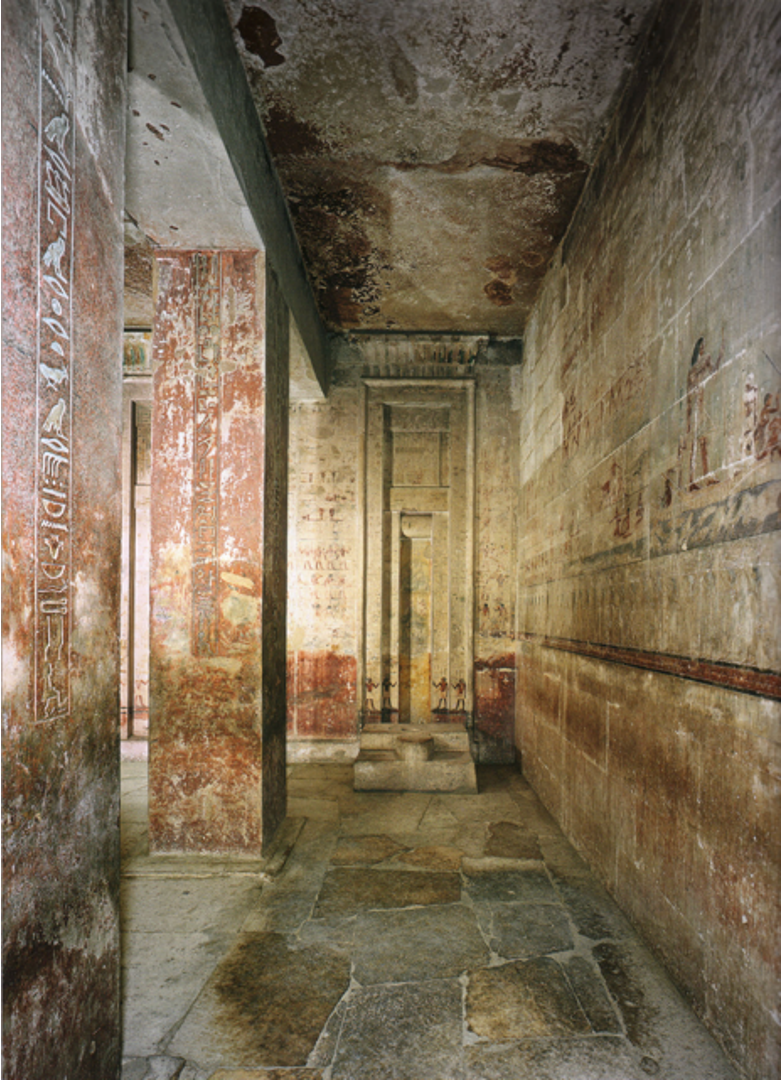
Where is it found?
Mastaba of Ti, Saqqara